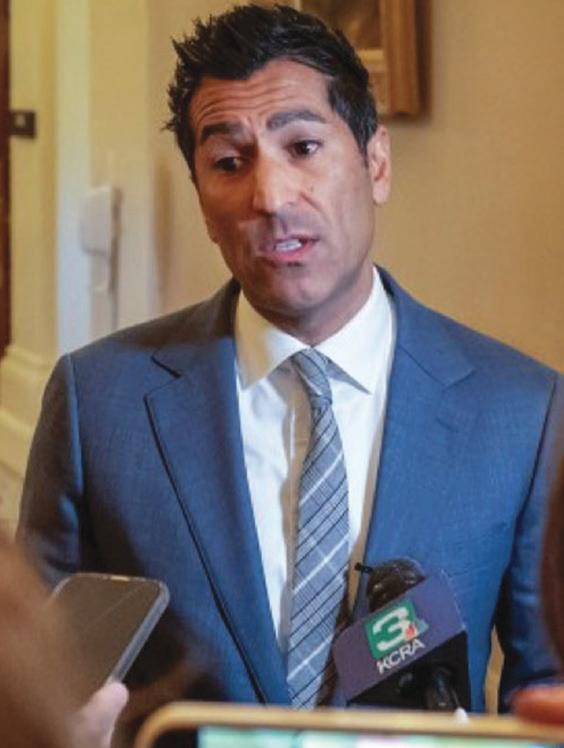

Gavin Newsom and Top Democrats are Deciding California’s Budget Behind Closed Doors Page A2

Michael Jackson’s Legacy: Fifteen Years After His Death, His Influence Continues

Baseball Legend Willie Mays Dies at 93
By Stacy M.
Willie Mays, the iconic Hall of Famer often hailed as the greatest player in baseball history, has died at 93. The news broke during a Mets and Rangers game in Arlington, evoking emotional tributes from the baseball community.
“He was the greatest I had ever seen on the field,” said Keith Hernandez, a New York Mets and St. Louis Cardinals legend, tearfully during the broadcast. Hernandez, who now serves as a color commentator for the Mets, reflected on Mays’ remarkable skills. “Willie would play a shallow centerfield, making it all the more amazing how he’d catch fly balls against the wall,” added Mets broadcaster Gary Cohen. “He was the greatest ever to play.”
Just a day prior, it was announced that Mays would not attend a special game honoring him and the Negro Leagues. Scheduled for Thursday, June 20, at Rickwood Field, the game features the San Francisco Giants and the St. Louis Cardinals. Mays, who began his career with the Birmingham Black Barons of the Negro Leagues, had shared his plans to enjoy the event from home. “I’m not able to get to Birmingham this year but will follow the game back here in the Bay Area,” he told the San Francisco Chronicle earlier in the week. “My heart will be with all of you who are honoring the Negro League ballplayers, who should always be remembered, including all my teammates on the Black Barons.”
Mays’ career spanned from 1951 to 1972 with the Giants, where he won a World Series in 1954, was a 24time All-Star, and was a two-time National League MVP. Among many other accomplishments, his 660 home runs and 12 Gold Gloves highlight his legendary status. The home run total came despite having taken a twoyear hiatus from baseball to serve in the military and having

played in the three toughest stadiums to hit home runs — The Polo Grounds, Candlestick Park, and Shea Stadium.
League Baseball, the city of Birmingham, and the Friends of Rickwood nonprofit group have collaborated
to renovate Rickwood Field, the oldest professional ballpark in the United States, to honor Mays and the Negro Leagues.
Despite his absence, Mays will be celebrated throughout the week’s festivities.
“My father has passed away peacefully and among loved ones,” Mays’ son, Michael Mays, announced. “I want to thank you all from the bottom of my broken heart for the unwavering love you have shown him over the years. You have been his life’s blood.”
Mays was not only a baseball legend but also a cherished figure in San Francisco. His 9-foot bronze statue stands proudly at Oracle Park’s 24 Willie Mays Plaza. He was eager to see MLB’s tribute at Rickwood Field, where he began his career.
Known for his exceptional five-tool abilities—hitting, power hitting, fielding, throwing, and base running—Mays also possessed an unmatched strategic acumen. In 2015, he received the Presidential Medal of Freedom from President Obama, who acknowledged Mays’ impact on sports and society. “It’s because of giants like Willie that someone like me could even think about running for president,” Obama remarked.
Mays was dedicated to helping others throughout his life, notably through his Say Hey Foundation, which supports underprivileged youth. “I do what I can for people, man,” Mays said in a 2021 interview. “When the kids ask me for something, I give it to them. Let them have it because they’re going to be here after I’m gone, and I want the kids to enjoy what they can enjoy.”
A career batting average of.302, 3,283 hits, and numerous honors define Mays’ legacy. He was inducted into the Baseball Hall of Fame in 1979, cementing his place as one of the sport’s all-time greats.
California 2024 Budget Agreement Includes Funding for Reparations Bill
We, as the California Legislative Black Caucus, made the case that the harms of slavery and racist public policies aren’t healed,” Bradford said. “This clearly states that reparations do matter and will be a priority in California going forward. This is just the beginning.”
By Joe W. Bowers Jr. California Black Media
In a move supporting vulnerable communities, the 2024 California budget agreement has earmarked $103 million in one-time funding for victims’ services programs. This allocation is designed to compensate for federal funding cuts and ensure continued support for crime victims across the state.
Grace Glaser of VALOR, a member of the California VOCA Advocacy Alliance, a statewide coalition of organizations dedicated to supporting survivors of crime, advocates, and their communities, praised this move, stating, “Gov. Newsom and the legislature have temporarily stitched [the safety net] back together with their commitment to one-time backfill funding, ensuring that for now, victims will receive support during the most traumatic and dangerous times of their lives.”
While grateful for the current funding, Glaser emphasized the need for ongoing financial commitment to ensure long-term stability for victims’ services in California. She said, “Our coalition will be back next year, urging Gov. Newsom and the Legislature to prioritize the needs of survivors of crime on an ongoing basis.”
The budget also allocates $12 million to support the implementation of reparations legislation enacted into law this session. This funding aims to help address historical injustices and promote equity and justice for Black Californians.
Assemblymember Lori Wilson (D-Suisun City), California Legislative Black Caucus (CLBC) Chair, told California Black Media: “I consider the governor’s allocation of $12 million for reparations resources a win. While the Legislative Black Caucus is committed to getting our legislative work on Reparations fully funded, I believe this is a positive start, especially during a challenging budget year. As I’ve always emphasized, this is a multi-year effort to implement the legislative recommendations in the report.”
The 2024 CLBC Reparation Priority Bill Package includes 14 measures being considered by the Assembly and Senate. Additionally, CLBC vice chair Sen Steven Bradford (D-Inglewood) has proposed two reparationsfocused bills not included in the package, also under review by the legislature. The deadline for each house to pass these bills is Aug. 31. Bradford expressed gratitude for the allocation of $12 million in the state budget for reparations, despite the state’s current financial challenges.
“This money will start to stand up the infrastructure to pay for future reparations. We, as the California Legislative Black Caucus, made the case that the harms of slavery and racist public policies aren’t healed,” Bradford said. “This clearly states that reparations do matter and will be a priority in California going forward. This is just the beginning.”
The 2024 Budget agreement reached between Newsom, Senate President pro Tempore Mike McGuire (D-North Coast), and Assembly Speaker Robert Rivas
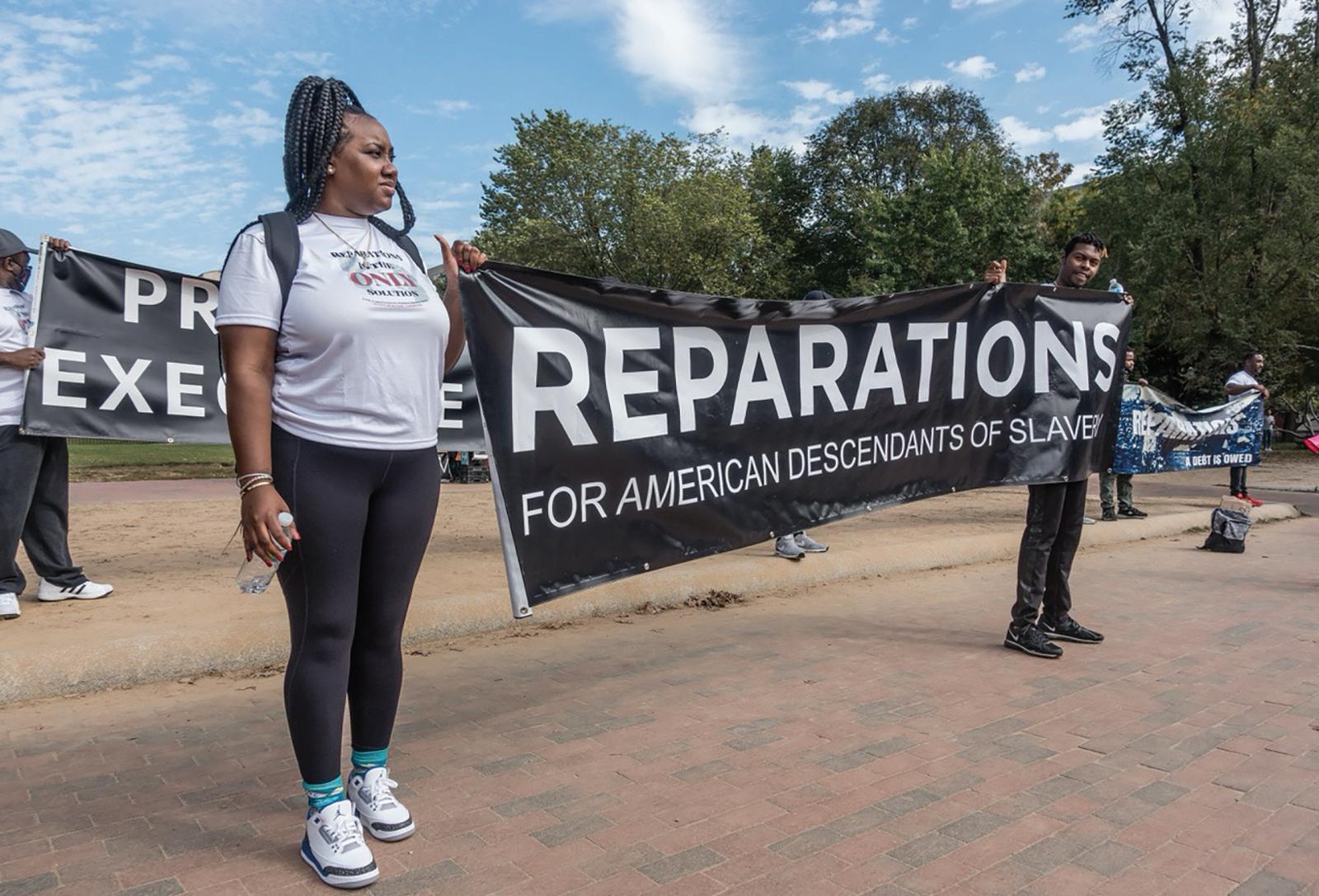
(D-Salinas) comes at a time when the state faces significant fiscal challenges. In his statement announcing the agreement, Newsom highlighted the budget’s role in establishing “long-term fiscal stability,” addressing both the immediate shortfall and strengthening resilience for the future. He noted the commitment to preserving programs that support millions of Californians, including “key funding for education, health care, expanded behavioral health services, and combating homelessness.” McGuire acknowledged that despite the difficult budget year, the situation was not as dire as initially feared. He pointed out that the budget addresses tough policy challenges by allocating resources to combat homelessness, investing in housing, and funding efforts to fight wildfires and retail theft. He also mentioned that the agreement ensures record funding for public schools, supports vulnerable communities, and addresses the climate crisis while maintaining responsible reserves.
Rivas’ statement focused on the Assembly’s efforts to protect vital public services and ensure long-term stability. He stated that the budget “prioritizes affordability and long-term stability,” securing investments to lower housing costs and sustain essential programs for vulnerable families. He emphasized the importance of balancing the budget while preserving a significant portion of the Rainy Day Fund to prepare for future challenges. “Accountability was a cornerstone of this journey, which included 72 Assembly budget hearings and hundreds of hours of public feedback,” he said.
The budget plan includes $297.9 billion in total expenditures, with $211.5 billion from the General Fund. It preserves significant reserves, with the Budget Stabilization Account projected to hold $22.2 billion at the end of the 2024-25 fiscal year. The agreement addresses a $46.8 billion deficit through a combination of reductions, revenue increases,
and fund shifts. About $16 billion in cuts come from state operations and various programs, including a nearly 8% reduction in state operations, saving $2.17 billion, and a $1.5 billion cut through the elimination of unfilled positions. The California Department of Corrections and Rehabilitation will see a $750 million cut over three years, with an ongoing annual reduction of about $560 million, including the deactivation of 46 housing units across 13 prisons.
The budget also includes $13.6 billion in revenue/ internal borrowing, $6 billion each in reserves withdrawals and fund shifts, $3.1 billion in expenditure delays and pauses, and $2.1 billion in payment deferrals. Revenue increases are achieved through suspending net operating loss deductions and increasing the Managed Care Organization tax. With an expenditure of $136 billion projected for TK12 and a per-student allocation exceeding $24,000, the budget safeguards classroom funding with constitutional protection against any revenue fluctuations the state may experience. Higher education will also see a 5% increase in base funding for the University of California and California State University systems to support enrollment growth. The budget maintains core programs like Medi-Cal, behavioral health services, and Supplemental Security Income/State Supplemental
Rapper Travis Scott Arrested after Miami Beach Police Say He Drunkenly Yelled at People on a Yacht
Officers went to the marina shortly before 1 a.m. after receiving a call about people fighting on a yacht, according to a police report.
When they arrived, they found Scott, 33, standing on the dock yelling at people on the ship, the report says. Officers told him to sit down, but he kept standing back up and yelling. They could smell alcohol on his breath, the report says.
The man who called police did not want to press charges, so Scott was allowed to leave. As he walked away, however, Scott kept turning to yell obscenities at people on the yacht. He left as a passenger in a waiting car, but returned five minutes later and ignored officers’ orders to again leave, the report says. Officers say he then began yelling again, disturbing people in nearby boats and buildings. When officers asked if he had been drinking, he replied, “It’s Miami.” He was arrested.
Scott was released from Miami-Dade County Jail before noon after posting a $650 bond.
After his release, he posted on the social platform X, “Lol.”
His attorney, Bradford Cohen, said in a statement that Scott was “detained due to a misunderstanding.”
“There was absolutely no physical altercation involved, and we thank the authorities for working with us towards a swift and amicable resolution,” Cohen said. Scott, one of the biggest names in hip-hop and whose birth name is Jacques Webster, has more than 100 songs that made the Billboard Hot 100 and released four singles that topped the chart: “Sicko Mode,” “Highest in the Room,” “The Scotts,” and “Franchise.” He has two children with his former girlfriend, media personality and businesswoman Kylie Jenner.
This is not the first time Scott has been involved in a police investigation.
Ten people were killed in a crowd surge at Scott’s 2021 performance at his Astroworld Festival in his native Houston. Attendees were packed so tightly that many couldn’t breathe or move their arms. Those killed, who ranged in age from 9 to 27, died from compression asphyxia, which an expert likened to being crushed by a car.
Lawyers for the victims alleged in lawsuits that the deaths and hundreds of injuries at the concert were caused by negligent planning and a lack of concern over capacity and safety at the event.
Scott, promoter Live Nation, and the others who were sued have denied these claims, saying safety was their No. 1 concern. They said what happened could not have been foreseen.
The final lawsuit was settled last month. After a police investigation, a grand jury declined to indict Scott, along with five others connected to the festival.
Cruise Ship with Broadway Stars to Steam off to Mexico in Spring 2025
By MARK KENNEDY AP Entertainment Writer
NEW YORK (AP) — A cruise ship with some of Broadway’s biggest names — including Tony Awardwinner Laura Benanti and Emmy-winner Wayne Brady — will sail from Florida to Mexico next spring. The Broadway Cruise — heading roundtrip from Miami to Cozumel, from March 31-April 4, 2025 — will also feature
and Broadway karaoke.
This will be the third Broadway Cruise, which borrows the Norwegian Gem for its themed trips. Patrons can see performances at everything from the 850-seat Stardust Theater to the Pool Deck Stage, which fits 2,000 or the Atrium Stage, which fits 300.
Willie Mays of the New York Giants (Courtesy Photo)
Brown NNPA Newswire Senior National Correspondent
Major
(Shutterstock Photo: Activist in Washington D.C. October 16, 2021)
Gavin Newsom and Top Democrats Are Deciding
California’s Budget Behind Closed Doors
By Alexei Koseff, CalMatters Sacramento Observer
(CALMATTERS) – After legislative leaders failed to reach an agreement with Gov. Gavin Newsom about how to close California’s projected multibillion-dollar deficit, the Legislature passed a placeholder state budget , just ahead of a mandatory deadline.
With only a few weeks left until the start of the new fiscal year on July 1, both sides refuse to publicly discuss what specific issues are holding up a deal.
Newsom’s office did not respond to an inquiry about remaining differences with the Legislature that still need to be worked out. Representatives for Senate President Pro Tem Mike McGuire and Assembly Speaker Robert Rivas, who are in charge of negotiating with the governor, declined to make them available to the media after their members approved a spending plan that almost certainly will not be the actual budget.
“There’s a shared set of priorities,” Assemblymember Jesse Gabriel, an Encino Democrat who leads the Assembly budget committee, told reporters following the vote. “It’s more about what are the most effective solutions, what are the programs and services that we think are the best way to go forward versus others.”
His counterpart on the Senate budget committee — Sen. Scott Wiener, a San Francisco Democrat — did not respond to an interview request.
Newsom presented a plan last month to address what his administration estimates is a remaining funding shortfall of $56 billion over the next two years, including by dipping into reserve accounts, deferring school funding, eliminating government jobs and cutting or delaying money for infrastructure, health and climate programs.
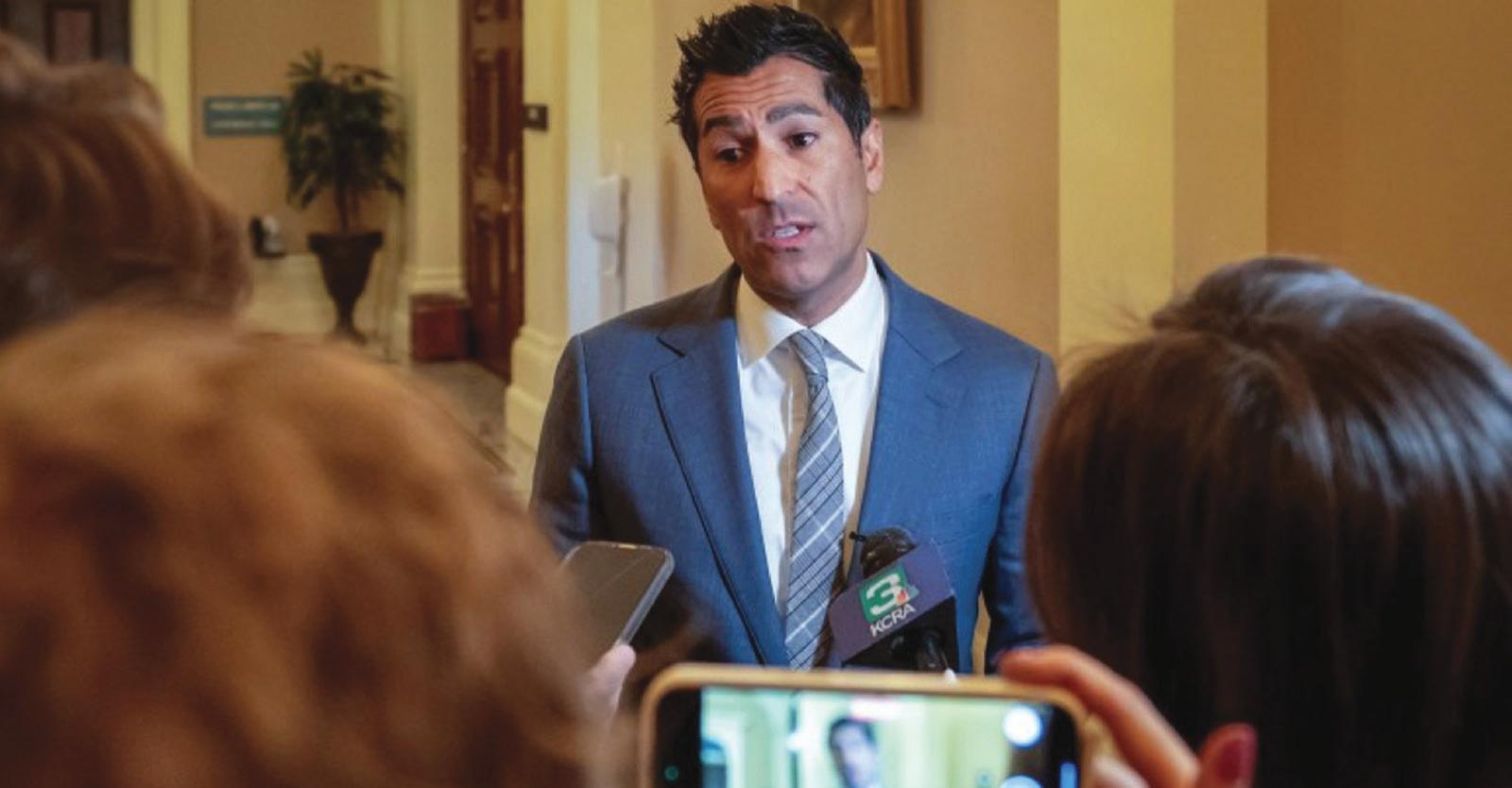
earmarked to increase payments for health care providers who treat low-income patients, as Newsom has suggested, and whether to further delay minimum wage increases for health care workers, which could potentially save the state billions of dollars but faces strong opposition from unions. Gabriel defended the process as “exceptionally transparent,” pointing to dozens of legislative budget hearings in which he said “there’s been a
process,” he said.
Despite ongoing negotiations over undisclosed provisions, Democratic lawmakers voted to adopt their version of the spending plan because they must pass a balanced budget by midnight Saturday in order to get paid. The bill passed by a vote of 29-8 in the Senate and 59-14 in the Assembly, along largely partisan lines. Republicans criticized the proposal as out of touch with Californians’ needs. They raised objections to provisions pausing some tax deductions for businesses to raise additional revenue and reversing previous commitments on expanded health care spending. Several members called out the inclusion of billions of dollars for the state’s troubled high-speed rail project and to expand health care access for undocumented immigrants while other programs are cut.
“This is a shameful budget,” Assemblymember Kate Sanchez, a Rancho Santa Margarita Republican, said during floor debate. “This budget is heartless, it’s
Bowman Battles for Political Survival Amidst
Contentious Primary in New York’s 16th District
By Stacy M. Brown NNPA Newswire
Rep. Jamaal Bowman (D-N.Y.) is fighting to retain his seat in New York’s 16th Congressional District in a highstakes and fiercely contested primary. Bowman, known as the “Hip-Hop Congressman,” recently spoke with the Black Press of America’s “Let It Be Known” digital news show, highlighting the critical issues at the heart of his campaign and the unprecedented financial backing his opponent has received. Bowman, a fervent progressive, is competing against George Latimer, a centrist, in a race that has seen significant outside spending and harsh personal attacks. Latimer has received significant financial support from AIPAC, which has invested over $14 million in the race, thanks to the backing of well-known individuals like Hillary Clinton. This has made the primary one of the most expensive House primaries in U.S. history, with total spending exceeding $23 million.
BakersfieldNews Observer
Adjudicated a Newspaper of General Circulation August 11, 1980, Kern County Superior Court Decree, Case No. 16964, Government Code 6023.
Bulk Mailing Permit 724 Bakersfield, CA 93385
Published By Observer Group Newspapers of Southern California, Inc. Corporate Office 1219 20th St. Bakersfield, CA 93301 (661) 324-9466.
Member of The National Newspapers Publishers Association, Associated Press, and The Better Business Bureau
President: Ellen Coley
CEO: Jon Coley
Publisher/ Editor: James Luckey Jr. Operations Manager: James Luckey Intern: William Clark Coley
Credo-The Black Press believes that America can best lead the world away from racial and national antagonisms when it accounts to every person, regardless of race, color, or creed full human and legal rights. Hating no person, fearing no person, the Black Press strives to help every person in the firm belief that all are hurt as long as any one is held back. The Observer Group Newspapers reserves the right to publish views an opinions that may not necessarily reflect those of the staff and management and are solely the product of the responsible individuals who submit commentaries published in these newspapers. Letters, articles and comments appearing in the Observer Newspapers reflect the opinions of the contributor and do not constitute the opinion or endorsement by The Observer Newspapers or its staff. The Observer Group Newspapers assumes no responsibility for photographs, articles, letters, press releases and unsolicited materials. Decisions as to the editing and publishing of materials are at the discretion of the Publisher and Editors. All rights are reserved on materials accepted for publication unless otherwise specified.
Bakersfield News
www.ognsc.com
During the interview, Bowman expressed deep concern over the influence of big money in politics. “We cannot have a democracy if we allow big money to control our politics and to allow big money and billionaires to buy our elections,” Bowman stated. He accused rightwing billionaires and groups like AIPAC of trying to install a more conservative candidate who would serve their interests. “They are trying to strip the power of the people away through real propaganda that misrepresents my record.”
The primary has emerged as a critical litmus test for the Democratic Party’s stance on Israel. Unlike other races focused on economic issues or support for President Biden, this contest has centered on the Middle East conflict.
Following Hamas’s attack on Israel on October 7, which resulted in nearly 1,000 Israeli civilian deaths, Israel’s military response has led to tens of thousands of Palestinian casualties. This has exacerbated the divide within the Democratic Party between staunchly pro-Israel members and those critical of the civilian toll in Gaza.
Bowman condemned the Hamas attacks as war crimes but also criticized Israel’s prolonged bombardment of Gaza. “We need a pathway to peace that doesn’t include the killing of babies, women, and children,” he said. He emphasized that most Americans support a permanent ceasefire, including the release of hostages, and criticized mainstream media for not adequately addressing these views.
Latimer’s record as Westchester County Executive has been scrutinized, particularly his handling of a federal mandate to desegregate the county. Despite campaigning
as an advocate for affordable housing, Latimer has woefully failed to meet the requirements of a 2009 consent decree, which ordered the county to build at least 750 affordable housing units and change restrictive zoning laws. Critics argue that Latimer’s administration made little progress, with only 723 units built and several municipalities maintaining exclusionary zoning practices.
Bowman highlighted Latimer’s history of inaction, stating, “He had fought against desegregation since the 90s when he was a county executive,” the congressman asserted. “Even though the federal government demanded that Westchester do more, he has slow-walked that call to action and won’t hold accountable the NIMBY community. Places like Scarsdale and Rye, where he lives, are the people who fund his campaign, and these are the people he works for.”
Latimer’s reluctance to take legal action against municipalities resisting desegregation efforts and his dependence on campaign contributions from affluent, predominantly white communities have been significant points of contention. These issues have largely escaped notice in mainstream media coverage, which has focused more on the personal attacks and financial aspects of the race than the underlying policy failures and implications for racial equity.
Bowman’s grassroots campaign contrasts sharply with Latimer’s corporate-funded bid. “For us, it’s always been about grassroots,” Bowman said. “We are knocking on doors, making phone calls, and doing everything we can to connect with voters so they don’t believe the propaganda that racist billionaires are pushing.”
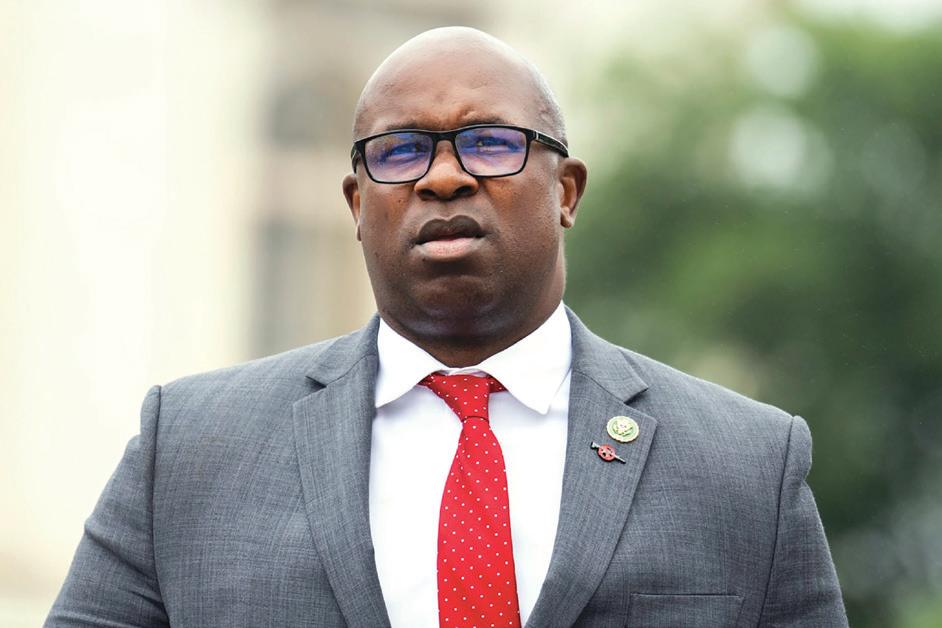
He also criticized the mainstream media’s role in perpetuating pay-to-play politics. “If mainstream media began to criticize pay-to-play politics, they wouldn’t have organizations like AIPAC running ads on their platforms,” Bowman argued. “It’s a plague of plantation politics, where working-class people, particularly of color, remain at the bottom.”
Bowman concluded with a strong message to voters: “We have to push back against the billionaires trying to buy our democracy. Vote for a representative who fights for the people, not the powerful.”
NNPA Annual Convention Ignites with Powerful Civil Rights Exhibit at Baltimore City Hall
By Stacy M. Brown
NNPA Newswire Senior National Correspondent In a stirring commencement to its annual convention, officials from the National Newspaper Publishers Association (NNPA) were feted during the unveiling of the “Marylanders Cry Freedom, Civil Rights at Home and Abroad” exhibit at Baltimore City Hall.
This unveiling of the touching exhibit included remarks by Baltimore Mayor Brandon Scott, Democratic Maryland Rep. Kweisi Mfume, NNPA President and CEO Dr. Benjamin F. Chavis Jr., National Chairman Bobby Henry, AFRO Publisher Dr. Toni Draper, and other dignitaries. The exhibit marked the 40th anniversary of Maryland’s groundbreaking divestment from South Africa’s
apartheid regime in 1984, a pioneering act of defiance that set a powerful precedent for other states.
The NNPA, representing over 250 African Americanowned newspapers and media companies, embodies the 197-year-old legacy of the Black Press of America while the exhibit stands as a testament to the Black Press’s unwavering activism and heroic efforts in championing civil rights both domestically and internationally.
Visitors to the exhibit were visibly moved as it evoked profound reflections on the struggle and progress of civil rights. Scott poignantly captured the sentiment, stating, “Because of their perseverance and unwillingness to back down, we’re here today. I am here today, and you are here today, able to hold power in these halls that used to serve
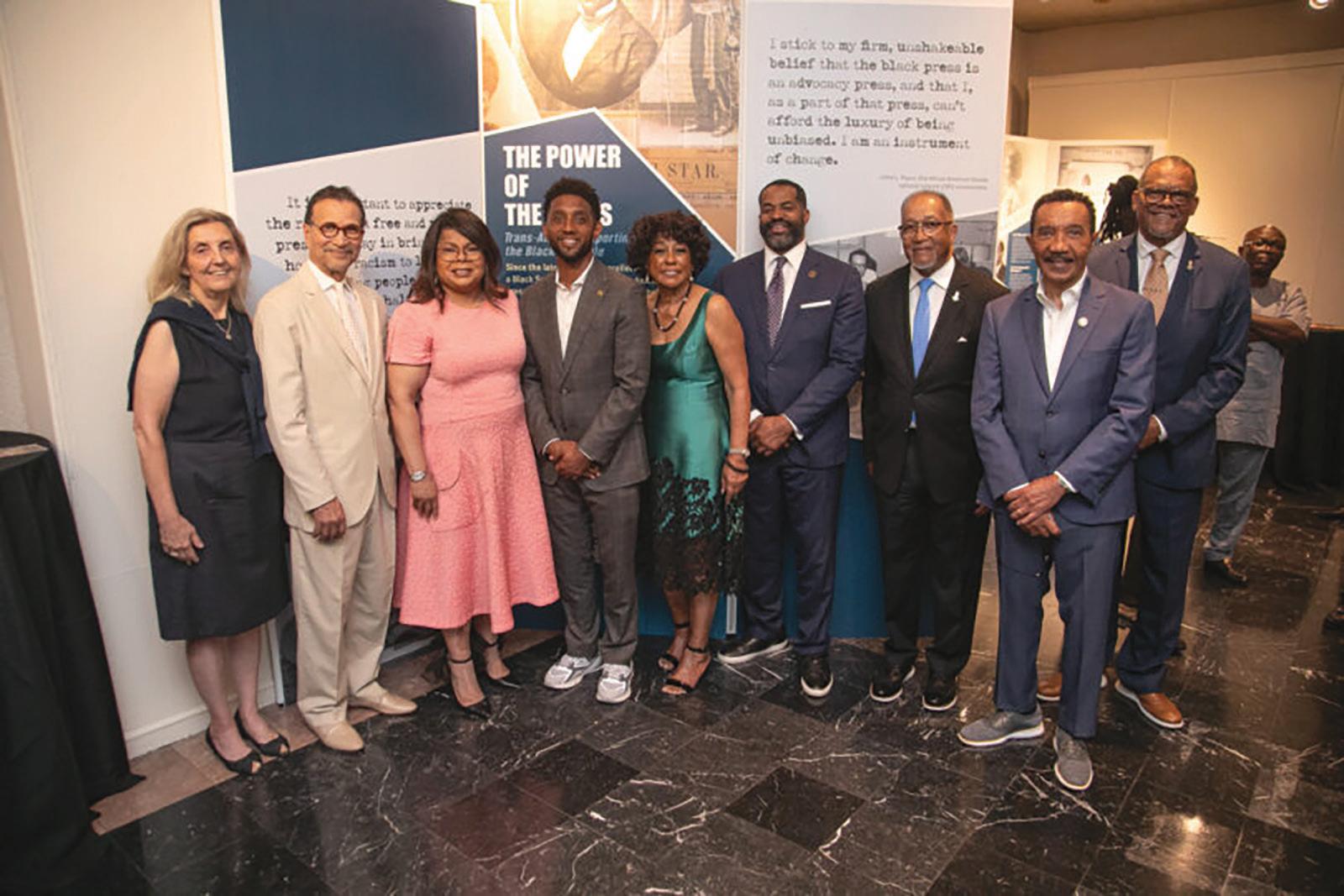
lawsuits to prevent those who look like us from achieving our excellence.” His words underscored the transformation from historical injustice to current empowerment within the same walls of City Hall.
Highlighting Baltimore’s critical role in the antiapartheid movement, Congressman Kweisi Mfume, who fought alongside Nelson Mandela, asserted, “Don’t think that Baltimore did not play a role. All those many years of people showing up and forcing the issue caused other cities to force the issue.”
His declaration affirmed the city’s significant contributions to global civil rights advancements.
The exhibit not only covers the struggle against apartheid but also delves into the eras of Jim Crow and other monumental civil rights movements in America. It vividly narrates the Black Press’s instrumental role in advocating for justice, showcasing the adversities and victories African Americans face.
“Marylanders Cry Freedom serves as a profound tribute to this pivotal moment in our state’s history, celebrating the unwavering determination of the people of Maryland to fight discrimination and injustice,” said Dr. Jean Bailey, project director and Chair of the Maryland/ KwaZulu–Natal (South Africa) Sister State Committee.
“It truly is a testament to the long-standing legacy of Marylanders as advocates for civil rights and social change.” Chavis, a former political prisoner as part of the Wilmington Ten in the 1970s, delivered a passionate commentary on the state of Black America and Africa. Drawing from his personal experiences, he underscored the importance of continued support for the Black Press and political engagement, making a direct appeal for backing President Joe Biden. His words, rooted in his own journey, resonated with the audience, emphasizing the crucial nature of unity in the upcoming elections.
Henry, the NNPA chair, also inspired attendees, emphasizing the strength found in collective action. “Together, each accomplishes much more,” he stated, reminding all the power of solidarity in the ongoing fight for civil rights.
The “Marylanders Cry Freedom” exhibit will be open to the public at Baltimore City Hall until August 31st. As the NNPA convention continues, this exhibit stands as a potent educational tool and a profound reminder of the Black Press’s enduring legacy. It serves to inspire future generations to continue the fight for justice and equality, as embodied in Henry’s exhortation: “Together, each accomplishes much more.”
Assembly Speaker Robert Rivas talks to reporters after the Assembly approved a measure to reduce the state budget deficit at the Capitol in Sacramento, on April 11, 2024. (Photo by Rich Pedroncelli, AP Photo)
Rep. Jamaal Bowman (D-N.Y.)
Senior National Correspondent
This unveiling of the touching exhibit included remarks by Baltimore Mayor Brandon Scott,
Michael Jackson’s Legacy: Fifteen Years After His Death, His Influence Continues
By Stacy M. Brown NNPA Newswire Senior National Correspondent
In what may have been his greatest triumph, a very frail and emotionally tested Michael Jackson walked out of a Santa Maria, Calif., courthouse on a sunny June day in 2005, having beaten 13 charges related to allegedly molesting a young cancer patient. As he slowly walked toward a waiting caravan of black SUVs, the King of Pop appeared almost unfazed, even dazed, by what had just occurred. He was exonerated but still drawn with a nearly puzzled look as many cheering fans stood by, one having released white doves signifying innocence. Joseph Jackson, the patriarch of the world-famous Jackson family, appeared to nudge his son’s arm upwards, helping him acknowledge the loyal fans from everywhere.
A reporter asked this journalist, “Where do you see Michael Jackson in five years?” The response was “Dead.” Unfortunately, almost four years to the date, that prognostication came true. Jackson had died of an overdose of the sedative propofol. He was 50, and a stunned world couldn’t conceive that it had lost the biggest pop music entertainer ever to grace the planet. At the time of his death, he was rehearsing for a series of London concerts aimed at reviving a career shattered by allegations, wild spending habits, and strange bedfellows. A Los Angeles court sentenced Dr. Conrad Murray, who was Michael Jackson’s personal doctor at the time of the singer’s death in 2009, to four years in prison for involuntary manslaughter in 2011.
Triumphs and Trials: A Complex Life
Michael Jackson’s rise to fame began early. He was the seventh of nine children. Born on August 29, 1958, in Gary, Indiana, Jackson joined his brothers Jackie, Tito, Jermaine, and Marlon to form The Jackson Five, a group that quickly rose to stardom. Jackson’s solo career, launched in the 1970s, reached unprecedented heights with the release of “Thriller” in 1982. The album became the bestselling of all time, with over 21 million copies sold in the United States and at least 27 million worldwide, cementing Jackson’s place as a global icon.
However, Jackson’s life was not without its challenges. His eccentricities, including his high-pitched voice, numerous plastic surgeries, friendships with children, and a pet chimpanzee, earned him the nickname “Wacko Jacko.” In 1993, he faced his first public child molestation allegations, which he vehemently denied. Although a jury acquitted him of all charges in a high-profile 2005 trial, the allegations severely damaged his reputation.
A U.S. tax court judge noted in 2021 that Jackson had “earned not a penny from his image and likeness in 2006, 2007, or 2008,” highlighting the lasting impact of these allegations. Despite this, Jackson’s popularity has surged in the digital era. According to Billboard, global consumption of his music grew from 4.7 billion to 6.5 billion on-demand streams between 2021 and 2023, a 38.3% increase. In February, the BBC reported that Sony Music Group confirmed it would acquire half of Jackson’s catalog in a deal valuing his music assets at more than $1.2 billion.
The Enduring Appeal of Jackson’s Artistry
Jackson’s artistry continues to captivate audiences.
“MJ The Musical,” a jukebox show featuring his music, has enjoyed successful runs on Broadway and in London’s West End. Next year will see the release of the Antoine Fuqua-
directed biopic “Michael,” starring Jackson’s nephew Jaafar Jackson. However, the musical and biopic have faced criticism for not addressing the abuse allegations in detail.
The New York Times noted that “no one’s looking at the man in the mirror” in its review of MJ The Musical, while the San Francisco Chronicle remarked that the show is “pop perfection” but has “an allegation-shaped hole.” This selective representation is part of a broader effort to rehabilitate Jackson’s image, which has been ongoing for decades.
A Legacy Beyond Controversy
Despite the controversies, Jackson’s impact on music and culture remains profound. British journalist Laura Lee Davies recalled the surreal publicity stunt for Jackson’s 1995 album “HIStory,” which included floating a 30-foot statue of Jackson down the River Thames. This spectacle was part of Jackson’s attempt to restore his image and remind the world of his extraordinary talent.
Jackson’s influence extends far beyond his lifetime. His music, characterized by innovative videos, groundbreaking dance moves, and genre-defying sounds, continues to inspire artists across the globe. His humanitarian efforts and vision of healing the world are integral to his legacy.
In 2018, the National Portrait Gallery in London hosted a major exhibition of Michael Jackson-inspired art featuring works by Keith Haring, Andy Warhol, and Faith Ringgold. The exhibition’s assistant curator, Lucy Dahlsen, explained to the BBC that the display aimed to be objective, celebrating Jackson’s achievements while acknowledging the more challenging aspects of his life.
The Dual Legacies of Michael Jackson
In her book “On Michael Jackson,” Pulitzer Prizewinning author Margo Jefferson explores the complexities of Jackson’s legacy. She notes that Jackson’s music and dance have influenced countless artists and sparked discussions on cultural identities and non-binary styles. Jefferson believes there are at least two legacies of Jackson: one for fans who appreciate his talent despite the allegations, and another for those who view him as a martyr and innocent victim.
Jefferson’s perspective on Jackson’s legacy might have shifted with present-day knowledge, especially in light of the 2019 documentary “Leaving Neverland,” which brought new abuse allegations. However, Jefferson argues that Jackson’s music and influence would have likely endured regardless.
Michael Jackson’s Influence Today
Today, Michael Jackson’s influence is seen in the work of numerous artists, from Bruno Mars to Beyoncé. His innovative approach to music and performance continues to inspire new generations. While the controversies surrounding his life may never fully dissipate, the BBC notes that Jackson’s contributions to music and culture remain a significant part of his legacy.
As fans mark the fifteenth anniversary of his death, Jackson’s star continues to shine brightly. His music, moves and overall talent resonate more than ever, proving that the King of Pop’s legacy is enduring and evolving.
As Jackson himself once said, “I’m just like anyone. I cut, and I bleed. And I embarrass easily.”

Ex-gang Leader Facing Trial in Tupac Shakur Killing Seeking Release from Vegas
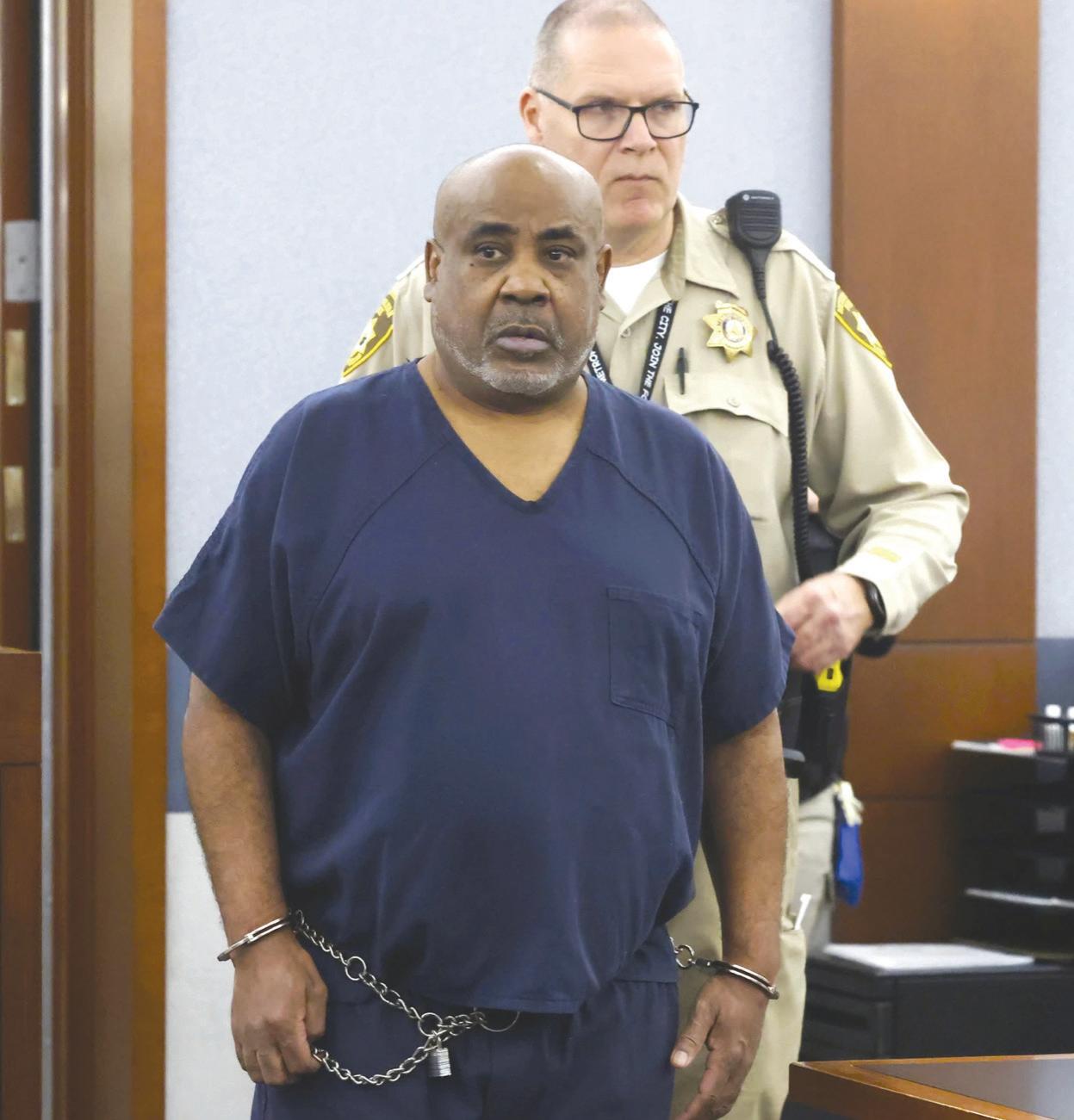
By KEN RITTER Associated Press
LAS VEGAS (AP) — A former Los Angeles-area gang leader accused of killing hip-hop music legend Tupac Shakur in 1996 in Las Vegas will ask a judge next week to let him out of jail to prepare for his trial on a murder charge.
Duane “Keffe D” Davis' attorney filed documents Thursday and a judge scheduled a hearing Tuesday at which Davis will ask permission to post $750,000 bond to be freed to house arrest with electronic monitoring.
Davis’ defense attorney, Carl Arnold, and a spokesperson did not immediately respond Friday to email and telephone messages about the court filing.
Davis has pleaded not guilty to first-degree murder and has remained jailed at the Clark County Detention Center in Las Vegas since his arrest last Sept. 29. His trial is scheduled Nov. 4. If convicted, he could spend the rest of his life in prison.
Prosecutors asked Clark County District Court Judge Carli Kierny to require a “source hearing” for Davis to demonstrate that any funds used to secure his release are obtained legally.
Representatives at Crum & Forster Insurance and North River Insurance Co., the Morristown, New Jerseybased backer of the bond identified in the court filing, did not respond Friday to telephone messages.
Davis is originally from Compton, California, but has lived in recent years with his wife and son in Henderson, a Las Vegas suburb.
He and prosecutors say he is the only person still alive among four people who were in a car from which shots
were fired in the September 1996 shooting that killed Shakur and wounded rap mogul Marion “Suge” Knight at an intersection just off the Las Vegas Strip. Knight is serving 28 years in a California prison for an unrelated case, the use of a vehicle to kill a Los Angeles-area man in 2015.
In the 27 years since the Shakur killing, Davis has publicly described himself as the orchestrator of the shooting, but not the gunman. A renewed push by Las Vegas police to solve the case led to a search warrant and raid at his Henderson home last July.
Prosecutors say they have strong evidence that Davis incriminated himself during police and media interviews since 2008, and in a 2019 tell-all memoir of his life leading a Compton street gang.
In the book, Davis wrote that he was promised immunity when he told authorities in Los Angeles what he knew about the fatal shootings of Shakur and rival rapper Christopher Wallace six months later in Los Angeles.
Support Black Press
The King of Pop (Wikimedia Commons)

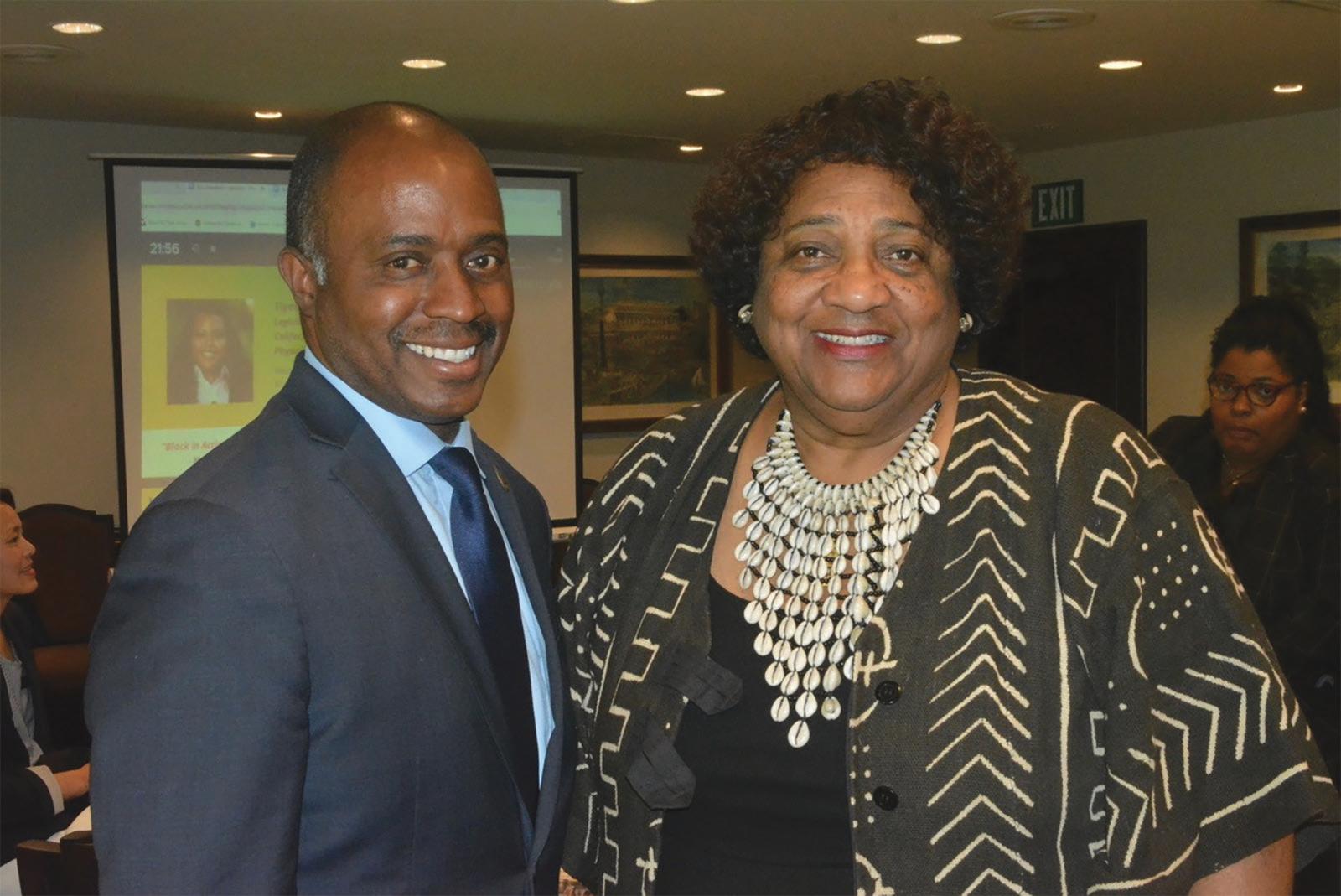
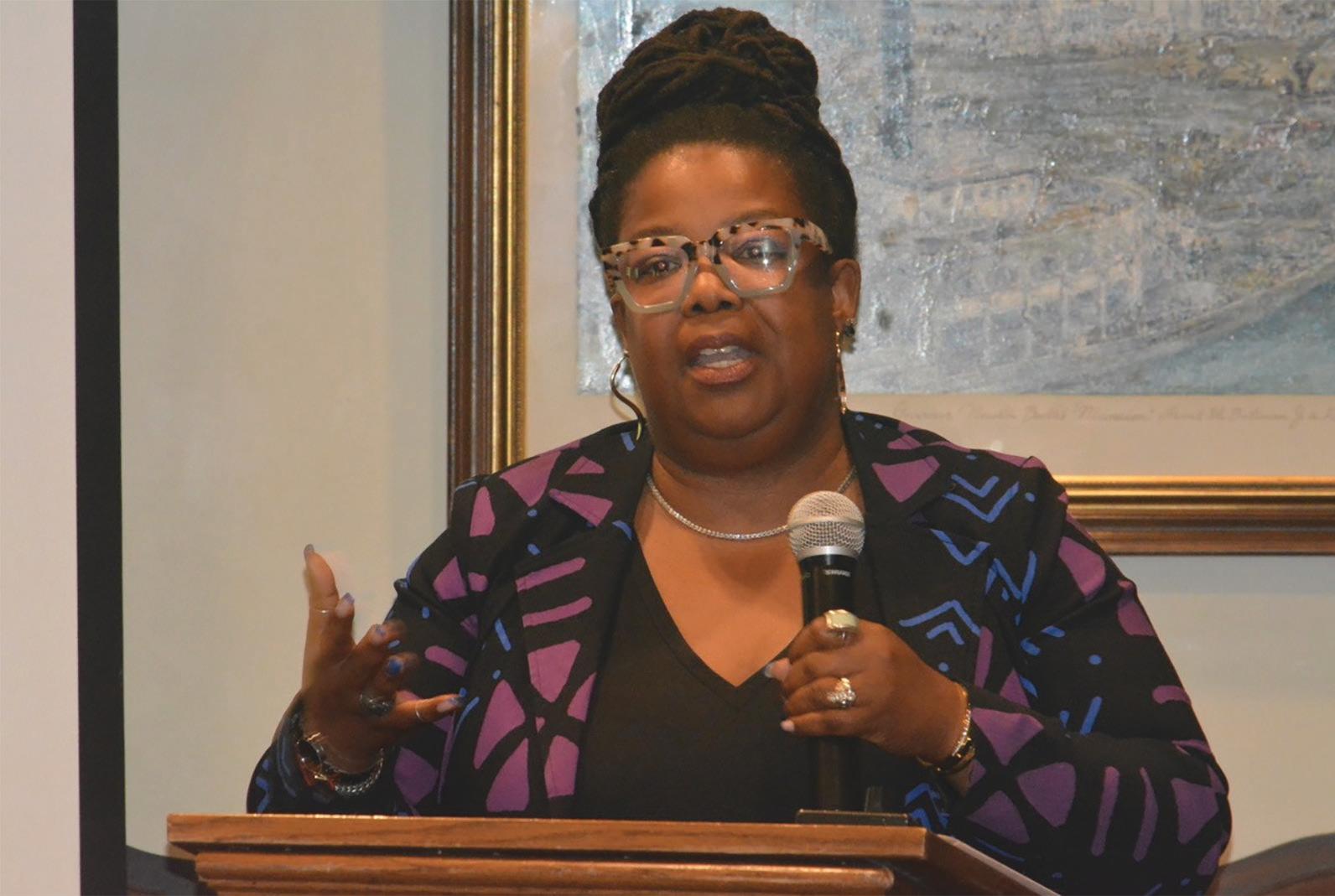
Black Leadership Council Honors California’s Three Black Constitutional Officers
By Antonio Ray Harvey California Black Media
The Black Leadership Council (BLC) honored Secretary of State Shirley Weber, State Superintendent of Public Instruction Tony Thurmond, and Controller Malia Cohen on June 19 during its Juneteenth Legislative Awards Luncheon in Sacramento.
Along with other awardees, California’s three Black constitutional officers were honored for their dedication to excellence, vision for equality, and awareness of political rights. The awards presentation was held at the Sutter Club near the State Capitol The state’s other constitutional officers are Gov. Gavin Newsom, Lt. Gov. Eleni Kounalikis, Attorney General Rob Bonta, Insurance Commissioner Ricardo Lara, State Treasurer Fiona Ma and the four members of the state’s Board of Equalization.
“It was a wonderful event. Well done,” Weber said. “They’ve honored some wonderful people. I am just proud to be a part of the list.” Honorees included Dr. Flojaune Cofer, an Epidemiologist, Policy Director, Community Advocate, and mayoral candidate in Sacramento; and Tomiquia Moss, who was appointed by Gov. Gavin Newsom as the Secretary of the Business, Consumer Services and Housing Agency (BCSHA) in November 2023.
Tiyesha Watts, a legislative and policy analyst for the California Academy of Family Physicians, was the youngest of the six honorees. She is well known around the State Capitol for being an outspoken advocate, bringing awareness to challenges people are facing in socioeconomically disadvantaged communities.
Tasha Henneman, Chief of Policy and Government Affairs for PRC (formerly Positive Resource Center), shared that she admired Watts’ leadership and extreme knowledge of the legislative process.
“I was immediately impressed by her intellect, professionalism, grace, and confidence from providing
expert testimony on a bill or just in a ‘me too’ moment, or just facilitating a meeting with a physician or budget staff,” said Henneman.
BLC co-chairs Brett Andrews, interim CEO of All Home; and Felton Institute CEO Al Gilbert provided opening remarks, along with PRC CEO Chuan Teng and board treasurer Darren Smith.
Kapri Walker, chair of the California Legislative Black Staff Association (CLBSA), addressed the need for more Black legislative staff. Walker, who is from San Diego, is a former Capital Senate Fellow. She said CLBS is currently raising money to fund interns.
Henneman referred to Walker as a “generational leader.”
“We are trying to strengthen the pipeline of young Black talent into positions of power,” Walker said.
BLC is a group of leaders whose work involves improving the conditions for Black Californians and other vulnerable populations across the state in housing, education, and healthcare. BLC also seeks to remove institutional barriers based on race, class, color, and zip codes.
BLC is co-sponsor of two pieces of legislation, Assembly Bill (AB) 2465, authored by Assemblymember Mike Gipson (D-Carson) and AB 2250 authored by Assemblymember Akilah Weber (D-La Mesa). Both are members of the California Legislative Black Caucus.
AB 2465 would level the playing field by requiring specific state agencies to implement equity in a specific set of grant programs where people of color and diverse-led organizations are underrepresented or non-existent. The Senate Standing Committee on Natural Resources and Water voted to advance the bill with a 7-2 vote on June 17.
AB 2250 would require a health care service plan contract or health insurance policy to include coverage for screenings for social determinants of health. It would also provide access to community health workers, promoters, representatives, peer support specialists, lay health workers,
and social workers.
The Senate Standing Committee on Natural Resources and Water passed AB 2250 with a 7-0 vote, but the legislation has been placed in the Suspense File while its fiscal impact is being reviewed.
In addition to the Legislative Awards Luncheon, BLC was at the State Capitol to commemorate Juneteenth by participating in “Black in Action Advocacy Day” – held to engage with key policymakers in Sacramento to advance systemic solutions for the most pressing issues facing Black
Californians, organizers said. “BLC to me is not just an organization or effort that is trying to systemically change the future for Black folks, it’s a movement,” Moss, a former co-chair of BLC, said while accepting her award. “It is a movement. As I occupy this role (secretary of BCSHA), I think about the shoulders that I stand on, I am so honored to be in this position to further our collective work.”
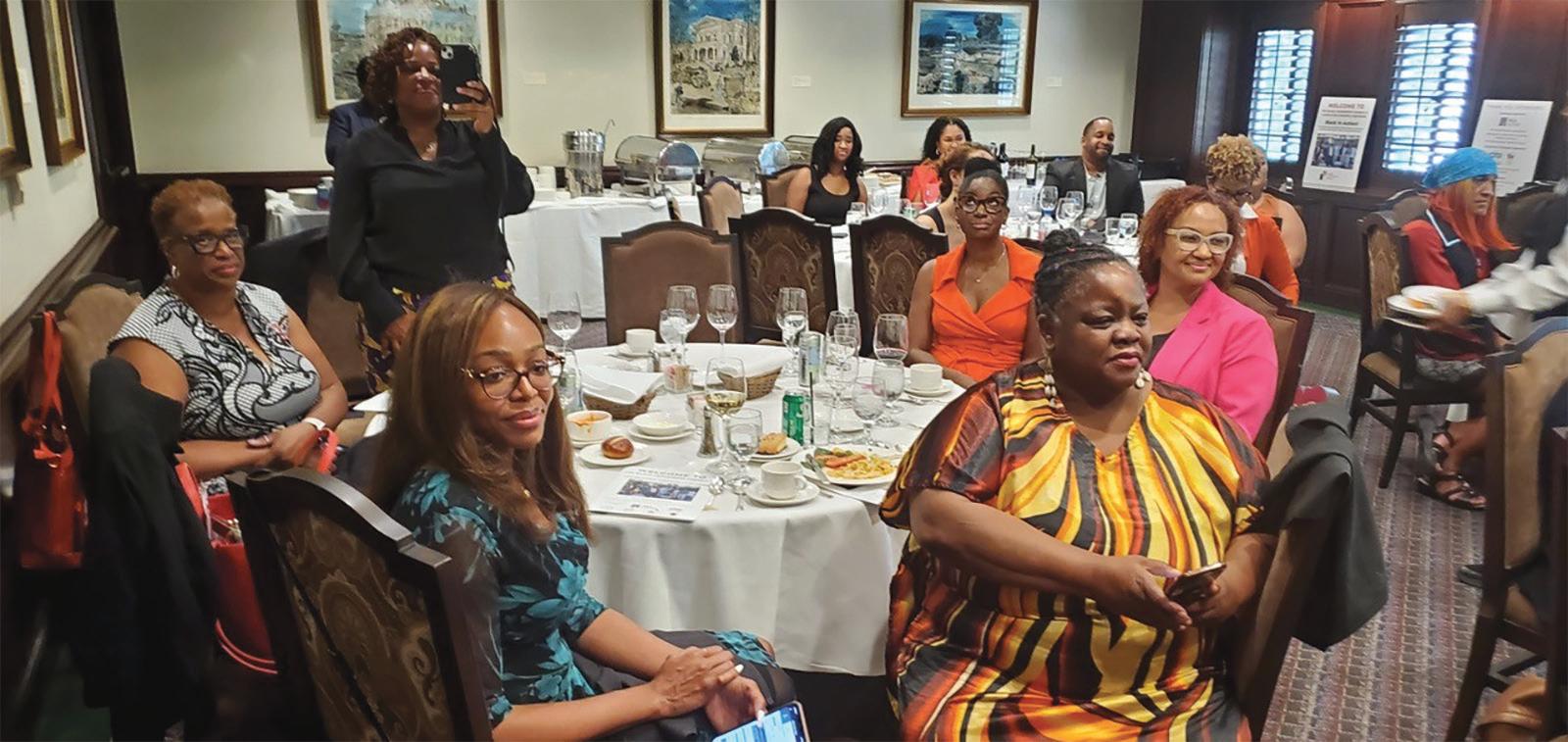
Black Californians Will Not Participate in the Greening of California If
State Doesn’t Do Better
Special to California Black Media Partners
California must act now to confront today’s Black job crisis. The Bureau of Labor Statistics last year reported that 90% of the nation’s unemployed U.S. citizens are Black Americans. And despite being less than 10% of LA’s population, Black people comprise more than a third of its unhoused residents.
Senate Bill (SB) 1340 renews hope in confronting this Black job crisis, as $180 billion in federal dollars are coming to California to fund the state’s green infrastructure projects over the next decade. The bill – authored by longtime worker rights and racial equity advocate Sen. Lola Smallwood-Cuevas (D-Los Angeles) – would establish local “disadvantaged worker” demographics across California and require state-funded contractors to prioritize hiring

these workers, who are primarily from underserved communities of color. One Black construction worker who has benefited from an equitable hiring program is Patricia Allen. In 2014, Allen was an unemployed single mother living in the Crenshaw area who was hired to work on LA Metro’s Crenshaw/LAX rail line as part of their Project Labor Agreement (PLA) that prioritized the hiring of local disadvantaged individuals. “It really felt good to see other faces like mine on the project,” said Allen, who now works as a safety supervisor for a construction company after earning her safety training certificate. “Without PLAs and other hiring programs, we’re not going to be able to get a fair chance to sit at the table.” SB 1340 would also require state-funded contractors to regularly track and report disadvantaged workers hired on their projects to hold them accountable to meeting equitable hiring goals established by the state. The Biden Administration has intended for states to utilize these federal grant dollars to boost equitable hiring programs and other community benefits. To remain competitive in securing future federal funding, California must demonstrate that it is successfully executing equitable hiring programs. Tracking and reporting are the most effective ways to ensure that California is keeping receipts on workers hired on development projects and ensuring that the communities they come from have benefited. California awarded one of its first contracts from these federal dollars to a Texas-based company. Without SB 1340, Black community members are concerned about the implications: firms like this out-of-state contractor are not currently required to hire local workers from vulnerable communities, including Black men and women.
“With billions of dollars flowing from the federal government to California for green infrastructure projects, now is the time to address the need for equitable hiring and
timely remediation,” said Emily Gartenberg, California Senior Policy Coordinator for Jobs to Move America. “California’s workers deserve action. With SB 1340, we can assure that an inclusive workforce will build our new green economy.”
As critical as SB 1340 is in helping to solve the state’s Black job crisis, the bill has fallen on deaf ears in the Governor’s Office. SB 1340 is yet to be funded, despite being passed by the State Senate and Assembly Labor Committee as well as strongly recommended by a sizable coalition of statewide community partners. While Gov. Newsom makes promises to support legislation that aim to make a more equitable California, Black workers need him to act now on those promises. Although California is facing budget constraints, SB 1340 will be a low-cost bill to implement. It’s a small investment that will pay big dividends given that it will create jobs that would take thousands of people out of poverty, ultimately saving the state money, with their taxpaying jobs reinvested back into the state.
Because of California’s long history of institutionalized racist policies, Black communities were excluded from building the state’s infrastructure during the 20th Century. SB 1340 would give Black workers an opportunity to play an important role as California transitions into a new green economy. But without this bill, Black workers will again be left out of the state’s latest reconstruction era.
and
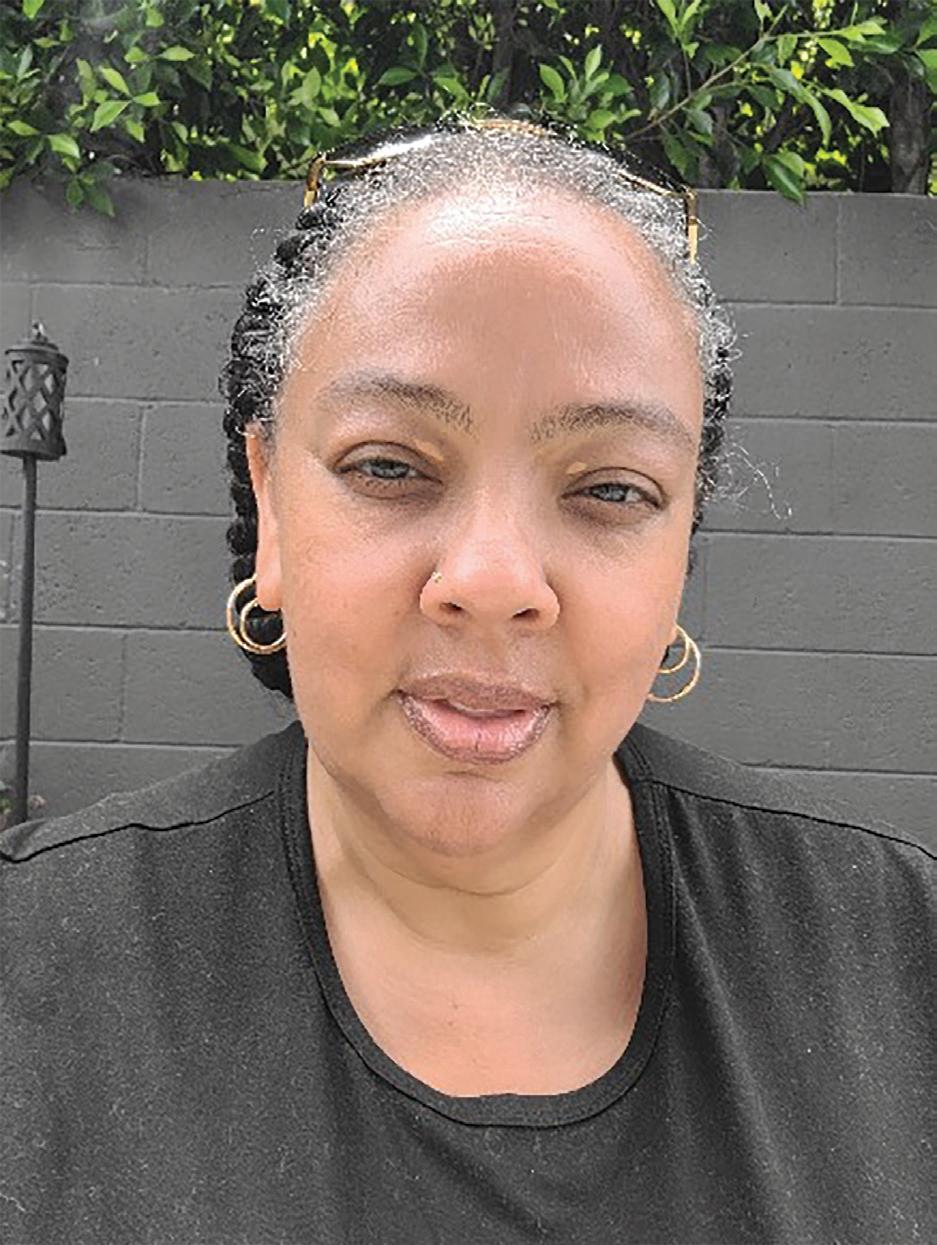
California Secretary of State Shirley Weber, right, and Superintendent of Public Instruction Tony Thurmond, left, were honored at the Black Leadership Council’s Third Annual Juneteenth Legislative Awards on June 19 in Sacramento. (CBM photo by Antonio Ray Harvey)
Tomiquia Moss, the California Secretary for Business, Consumer Services, and Housing Agency, shares her thoughts about the importance of the Black Leadership Council. (CBM photo by Antonio Ray Harvey)
The Black Leadership Council’s Third Annual Juneteenth Legislative Awards was held at the Sutter Club on June 19 in Sacramento. (CBM photo by Antonio Ray Harvey)
Taylor Jackson, Regional Organizer, Southern California Black Worker Hub
Dawn Modkins, Director, Southern California Black Worker Hub
By Taylor Jackson
California Capitol News You Might Have Missed Political Playback:
By Bo Tefu and Antonio Ray Harvey California Black Media Calif. Sec. of Transportation:
State on Course to Future Without Gas-Powered Cars
As California pushes toward a zero-emissions future by 2035, petroleum use is expected to decline significantly over the next decade.
But Secretary of Transportation Toks Omishakin said a decline in transportation revenue is currently not an “urgent” matter.
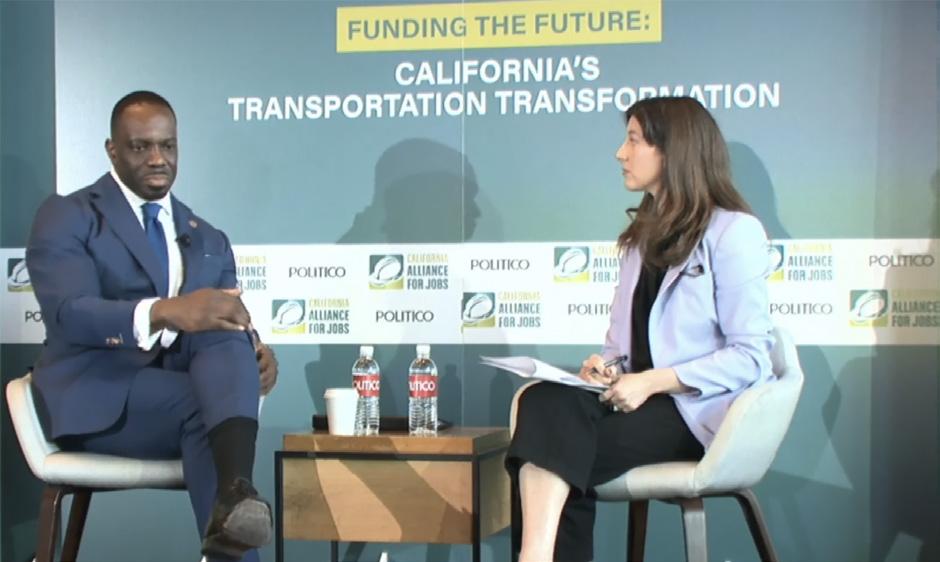
an integral part of San Francisco’s cultural fabric and a cherished member of our community. His legacy will forever be intertwined with the legacy of the city he loved,” he said.
hard-won freedom after providing free labor illegally for two-and-a-half years in Texas.
Omishakin explained how the state is projected to handle a $4 billion-plus shortfall in gas tax revenue at the “Funding the Future: California’s Transportation Transformation” seminar, held on June 18 at the Kimpton Sawyer Hotel in Sacramento.
“I would say that we are not at a place where we’re losing gas tax funding yet,” Omishakin said to moderator Debra Kahn, California Policy Editor at Politico.
“Some people say that we are, but we’re not,” Omishakin continued. “We’re going to be up 57.9 to 59.7 cents (after July 1). That’s going to be the gas tax but we’re not losing revenue,” he added.
According to a December 23 report by the Legislative Analyst Office (LAO), in the next 10 years, Californians could see a decline of $5 billion or 64% from the state’s gasoline excise tax, $290 million or 20% from the diesel excise tax and $420 million or 20% from the diesel sales tax.
“We estimate that these declines will be partially but not fully offset by projected increases in revenues from an existing annual registration fee levied on battery-electric and hydrogen-fueled cell vehicles ($1 billion),” the LAO report stated.
The projected revenue shrinkage is expected to affect some transportation programs that support state and local transportation projects and activities, according to LAO. The California Department of Transportation’s highway maintenance and rehabilitation programs, subsidized by state fuel taxes, could also be affected by cuts.
LAO’s report states that the existing annual registration fee attached to battery-electric and hydrogen-fueled cell vehicles should increase revenues to $1 billion. However, the report also projects an estimated decline of $4.4 billion in annual state transportation revenues.
“I haven’t had a lot of time to look at the LAO’s projections but (it’s) possibly accurate on many fronts,” Omishakin said. “So far, we’re not at a place where we are losing revenue. That is a key thing to keep in mind.”
Hosted by Politico and presented by California Alliance For Jobs, the event explored the future of transportation infrastructure, transit, pedestrians, bike lanes, local streets, highways, bridges, overpasses, and electric vehicles.
Other participants included Assemblymember Lori D. Wilson (D-Suisun City), chair of the Assembly Transportation Committee and the California Legislative Black Caucus; Emily Cohen, California High-Speed Rail Authority Executive Vice President of United Contracts; Michael Pimentel, Executive Director of California Transit Association; and Sen. Dave Cortese (D-Campbell).
As part of the Advanced Clean Cars II regulations, all new passenger cars, trucks, and SUVs sold in California will be zero-emission vehicles by 2035.
Omishakin said, across California there are up to 1.9 million “light-duty” EVs, 400,000 “medium-to-heavy duty” EVs (50% are public transportation buses), 105,000 charging stations, and 500,000 home chargers.
“On one side, we’re doing extremely well. The rest of the world is following our steps in leadership. Thanks to the leaders of the state, Gov. Newsom, the legislature, and key staff – we are leading the way on EVs,” Omishakin said. “We’re hitting the ball out of the park.” Gov.
Newsom, Other California Leaders, Pay Tribute to Baseball
Great Willie Mays
Last week, Gov. Gavin Newsom, several California government officials, private sector leaders and Americans from all walks of life paid tribute to former San Francisco Giant, Major League Baseball (MLB) great, and Negro Leagues icon Willie Mays, who passed away at 93 on June 18.
Nicknamed “The Say Hey Kid,” Mays made history as one of the greatest baseball players in MLB. A powerful hitter and center fielder, his sportsmanship and athleticism earned him a spot in the Baseball Hall of Fame in 1979. Mays played in the Negro American League for the Birmingham Black Barons. He was a pioneer and legend in baseball as one of 10 Black players in the 1950s securing a contract with a major league team.
Newsom acknowledged Mays as a baseball icon and role model who broke barriers, set world records, and inspired future generations of athletes.
“I am deeply saddened by the loss of my friend, Willie Mays,” said the Governor.
“His impact extends far beyond baseball. He became
Throughout his career, Mays was renowned for ‘The Catch’ during the 1954 World Series after catching a fly ball over his shoulder with his back to the diamond. This play was marked as one of the greatest catches in the history of baseball.
San Francisco Giants Chair Greg Johnson called Mays a hero and praised the 24-time All-Star athlete for his contributions to the game of baseball and the fabric of America.
“Today we have lost a true legend,” said Johnson. “In the pantheon of baseball greats, Willie Mays’ combination of tremendous talent, keen intellect, showmanship, and boundless joy set him apart.”
San Francisco Mayor London Breed called Mays “the greatest player of all time.
“To a native San Franciscan, some things just go without question: it’s foggy in the summer, cable cars go halfway to the stars, and Willie Mays is the best there ever was,” wrote Breed in a statement. “It was an unbelievable opportunity of a lifetime to meet someone like Willie Mays. I remember hearing about the struggles that he endured because he was Black, and what he overcame to become an icon on the field.”
Sen. Steve Cortese (D-San Jose) said Mays contributions to baseball and the Bay Area are “immeasurable.”
Watching Willie Mays play was a privilege I will never forget. As great as he was at the sport, he was an even better man. His work through the Say Hey Foundation stands as just one example of how he made our community stronger,” said Cortese.
California Assembly Speaker Robert A. Rivas (D-Hollister) also saluted Mays.
“The greatest. Rest in Peace, Willie Mays,” Rivas posted on the social media platform X.
California’s U.S. Senators Padilla and Butler Support Bill That Would Double Pell Grants
California’s U.S. Senators Alex Padilla and Laphonza Butler announced last week that they are backing White House efforts to expand Pell Grant awards for working students and families.
The Pell Grant Preservation and Expansion Act of 2024 is bicameral legislation that aims to make college more affordable for low-income students. The initiative will double the Pell Grant to students and undocumented immigrants pursuing higher education. The California senators are among several U.S. senators who have thrown their support behind the legislation.
Sen. Patty Murray (D-WA) is the sponsor of the bill.
Butler, a former recipient of a Pell Grant, highlighted that the program helped her further her studies and afford a college education.
“As a proud recipient of the Pell Grant, I know the transformative power of the program in turning the dream of higher education into a reality for students in California and across the nation,” said Butler.
“We must expand the Pell Grant Program to put higher education in reach so that every student has the opportunity to succeed,” she said.
With this new initiative, the program will index maximum awards for inflation. If passed, the measure will make Pell Grant funding fully mandatory to protect it from funding shortfalls. The act would also restore eligibility for the program up to 18 semesters for students.
Padilla, a first-generation college graduate, acknowledged that the Pell Grant supported his goal to attend college and overcome financial challenges.
“Every student deserves the opportunity to pursue higher education, no matter the size of their parent’s paycheck,” said Senator Padilla.
“As a proud first-generation college graduate, I know the challenges students face in accessing an affordable education, especially as the cost of education continues to climb,” he said.
“A Time to Reflect and Rejoice”: Black Caucus Members Commemorate Juneteenth on Assembly Floor
On June 17, two days before Juneteenth, members of the California Legislative Black Caucus (CLBC) delivered remarks on the Assembly floor commemorating the national holiday and its significance in American history.
ACR 192, introduced by Assemblymember Reggie Jones-Sawyer (D-Los Angeles), aims to honor and reflect on the emancipation of African Americans from chattel slavery and honor their contributions throughout America’s history.
Speaking on the Assembly floor, Jones-Sawyer said the resolution is the CLBC’s annual commemoration of Juneteenth as “Freedom Day.”
“Two years after President Lincoln issued the Emancipation Proclamation in 1863, The bell of freedom rang true for over three million Black Americans, marking the beginning of the fight to secure the freedom of those still enslaved and provide fair and equal treatment for the formerly enslaved,” Jones-Sawyer said.
“Juneteenth is a time to reflect and rejoice for all the work it took to reach this point, as well as a reminder that true equality is not accomplished overnight,” he added.
“While there have been great strides to acknowledge and address the history and plight of Black Americans, society, as a whole, still has a long way to go. Juneteenth is an opportunity to educate all communities that we may not repeat injustices and abuses committed in the past.”
The resolution particularly highlights how Black Americans have helped enrich American civic life through their steadfast commitment to promoting unity and equality.
Assemblymember Dr. Akilah Weber (D-La Mesa), also a member of the CLBC, spoke on behalf of the Women’s Caucus in support of Assembly Concurrent Resolution (ACR) 192, the California Legislature’s resolution acknowledging the federal holiday and celebrating the emancipation of African Americans from slavery. Weber highlighted that African Americans won their
Weber shared the story of Opal Lee, known as the “Grandmother of Juneteenth.” Lee is among numerous civil rights activists and leaders who campaigned for decades for June 19th to be recognized as a federal holiday. Lee traveled around the country educating people about Juneteenth and led walks each year commemorating Juneteenth before it was federally recognized.
At 89, Lee led a symbolic walk, said Weber, from her hometown of Ft. Worth, Texas, to Washington, D.C., leaving in September of 2016 and arriving in January of 2017.
Juneteenth became a federal holiday in 2021 and Lee was awarded the Presidential Medal of Freedom in 2024 for her activism.
“Lee represents the millions of women throughout the history of this country who have worked tirelessly to ensure that our history is not erased, reframed nor ignored,” said Weber.
Other lawmakers who recognized Juneteenth on the Assembly floor included Assemblymember Lori Wilson (D-Suisun City), Chair of the CLBC; Eloise Gomez Reyes (D-Colton), chair of the California Legislative Latino Caucus; Assemblymember Jim Patterson (R-Fresno); Assemblymember James C. Ramos (D-San Bernardino), chair of the California Native American Legislative Caucus; and Assemblymember Corey Jackson (D-Moreno Valley), also a member of CLBC.
“It is a call-to-action for all Californians to interrogate the systems that keeps others in bondage,” said Wilson.
Gov. Newsom Announces He Backs a Ban on Cellphones in Schools
Gov. Gavin Newsom wants to restrict the use of smartphones in K-12 schools statewide, he announced on Tuesday.

The Governor stated his intentions amid warnings from President Joe Biden on the harmful impact of social media on children. The announcement followed a report released by the U.S. Surgeon General Vivek Murthy that calls on Congress to regulate social media platforms. Proposed regulations include warning labels on harmful content that may hurt minors active on social media. The governor stated that he plans to sign a law that authorizes school districts to limit or ban the use of smartphones by students or require the supervision of a school employee.
“As the Surgeon General affirmed, social media is harming the mental health of our youth. Building on legislation I signed in 2019, I look forward to working with the Legislature to restrict the use of smartphones during the school day,” said Newsom.
“When children and teens are in school, they should be focused on their studies — not their screens,” he said.
In 2022, Newsom authored a letter urging companies in the tech industry to drop a lawsuit against the children’s online safety law he signed that same year. Newsom aims to take online safety laws a step further allowing school districts to ban or limit the use of smartphones to help protect children from the harmful effects of social media.
The California School Boards Association argues that any rules on the use of smartphones should be regulated by school districts as opposed to the state.
Troy Flint, the school board’s spokesperson, said that school districts should make the final decision on regulations over smartphones.
“We support legislation which empowers school leaders to make policy decisions at a local level that reflect their community’s concerns and what’s necessary to support their students,” said Flint.
The Los Angeles Unified School District (LAUSD) supports Gov. Newsom’s plan to ban smartphones during school hours, stating that smartphones and devices distract students from learning and facilitate cyberbullying.
On June 18, LAUSD voted to ban the use of cellphones during the school day.
In a similar light, Sen. Henry Stern (D-Malibu) proposed SB 1283 earlier this year. If passed, the legislation will give school districts more authority to limit the use of social media at school. SB 1283 is currently under review in the Assembly Education Committee.
“It’s just too hard for every teacher, every school, or every parent to have to figure this out on their own,” said Stern. “There are some times when government just has to step in and make some bigger rules of the road.”
A similar bill, AB 3216, introduced by Assemblymembers Josh Hoover (R-Folsom), Josh Lowenthal (D-Long Beach) and Al Muratsuchi (D-Rolling Hills Estates), is being considered by the Senate Education Committee.
The bills would take effect in January if passed by the Legislature and is approved by the Board of Education in school districts that support the cellphone ban.
Calif. Supreme Court Upholds Decision That Eliminated Black Jurors From Death Penalty Cases
Last week, the California Supreme Court voted 5-2 to uphold an Alameda County court’s decision to issue death penalty sentences in over 30 trials, ruling that the prosecutors had valid reasons to dismiss Black jurors. “We conclude in each instance the prosecutor’s reasons
were inherently plausible and supported,” the court ruled. The court cited evidence from jury questionnaires and the prosecutors’ questions directed to the jurors removed from the trial.
In April, a federal judge ordered Alameda County to review over 30 death penalty convictions following allegations that the Alameda District Attorney’s office removed Black and Jewish people from juries. The trials reviewed included a case that involved a jury in February 2000 that found Giles Albert Nadey guilty of murder and sodomy, sending him to death row. During this trial, a California prosecutor removed five out of six Black
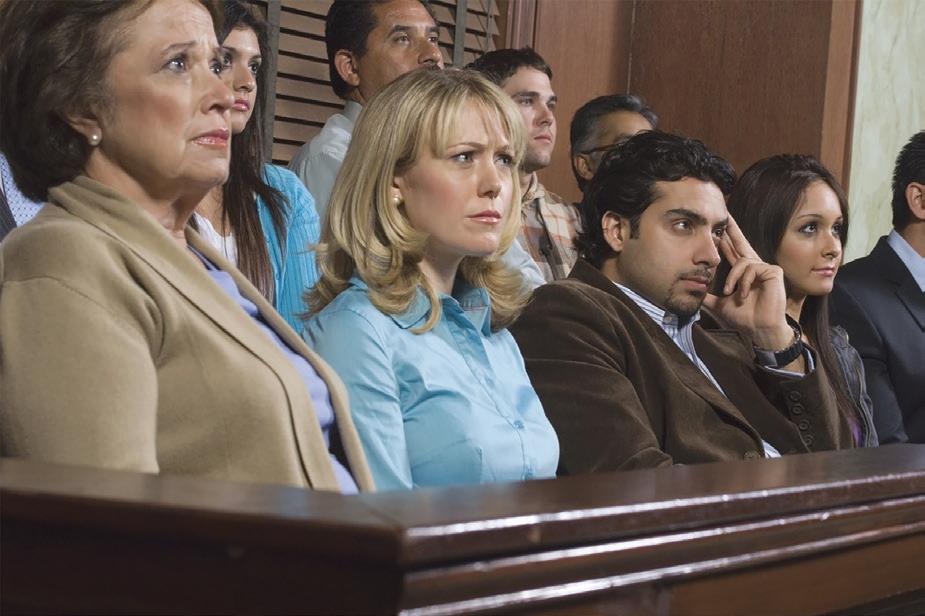
women from the jury pool. According to the prosecutor, some of the Black jurors were reluctant to impose the death penalty. Other Black women had liberal views, the court concluded, that may clouded their judgment. The defense team eliminated the last Black women from the jury and continued the trial with no Black women serving on the jury.
The court appeal in Nadey’s case alleged that his case was affected by racial bias. However, the Supreme Court decided to uphold the initial ruling and found that the State prosecutor’s decision to remove Black jurors was justified.
Capital punishment remains a complex issue in California’s criminal justice system, although Gov. Gavin Newsom declared a moratorium on executions. The executive order declared that “death sentences are unevenly and unfairly applied to people of color, people with mental disabilities, and people who cannot afford costly legal representation.”
A report by The Sentencing Project indicated that African Americans are skeptical about pursuing the death penalty in cases. Therefore, criminal justice advocates argue that prosecutors prefer juries that support capital punishment, often excluding Black jurors. California laws allow convicts to appeal court rulings based on racial bias in criminal hearings. Criminal justice advocates continue to push back on the death penalty and call for more accountability in the courts.
California Supreme Court Blocks Anti-Tax Measure From Appearing on November Ballot
On June 20, the California Supreme Court decided to prevent placing an anti-tax initiative on the November ballot, ruling in favor of Gov. Gavin Newsom and Democratic legislators.
The Taxpayer Protection and Government Accountability Act aimed to challenge the increase of taxes in California. The initiative calls for prohibiting the Legislature from raising or introducing new taxes without voter approval.
Gov. Gavin Newsom and Democratic legislative leaders sued last year to block the tax anti-measure.
According to the court ruling, Gov. Newsom and legislators petitioned to halt the initiative, arguing that it “is invalid because it attempts to revise the California Constitution via citizen initiative.”
Court documents stated that the petitioners argued
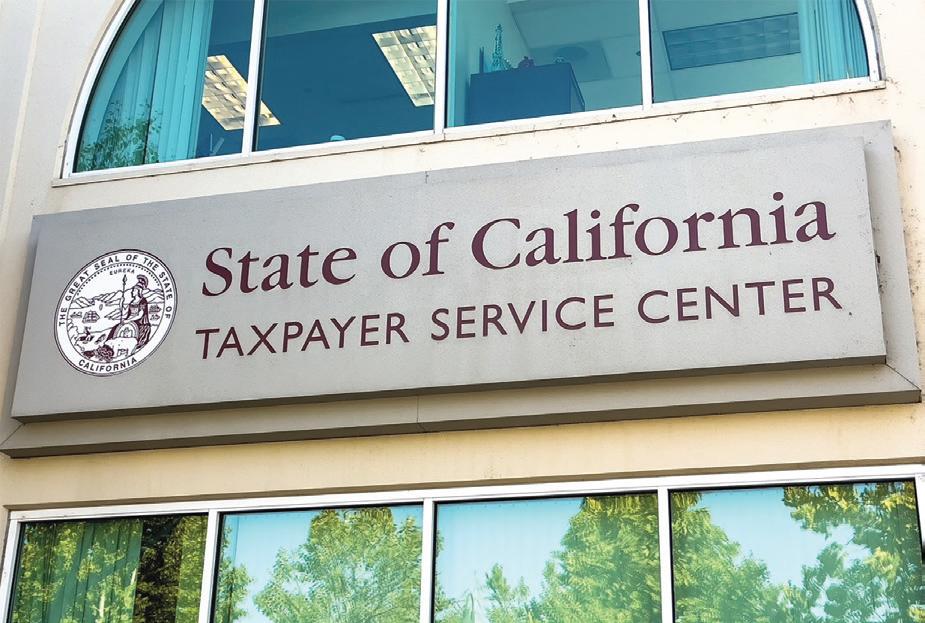
that the anti-tax measure, “is invalid because it would seriously impair essential government functions.”
Justice Goodwin Liu stated that the electorate had the right to enact the proposed changes.
In the court ruling, Liu stated that the proposed changes, “would substantially alter our basic plan of government. The proposal cannot be enacted by initiative. It is instead governed by the procedures for revising our Constitution.” Under current state law, only a supermajority of the Legislature or a constitutional convention can submit proposed revisions to voters for approval.
California labor unions celebrated the court’s decision and celebrated the ruling on the social media platform X.
Tia Orr, executive director of the Service Employees International Union (SEIU) California Chapter, said the ballot measure was harmful.
“The threat to destroy California w/ greed and hubris lost today,” she wrote on the social media platform X, celebrating the High Court’s decision.
“Developers, landlords & corporations: our democracy is not your plaything to rearrange with your checkbook,” Orr added.
The court ordered Secretary of State Shirley Weber to stop any efforts to place the anti-tax measure on the November ballot.
California Secretary of Transportation Toks Omishakin, left, talks to Politico’s Policy Editor Debra Khan, right, about gas tax revenue and electric vehicles during the Funding The Future: California’s Transportation Transformation conference on June 18 in Sacramento. Screenshot.
(Shutterstock Photo)
(Shutterstock Photo)
(Shutterstock Photo)
A Parent’s Guide to HIV Awareness Talk, Trust, Test:

By Brittinae Phillips
The first cases of HIV were reported in Los Angeles in June 1981. For 43 years, it has impacted our lives, with thousands still contracting HIV each year. As parents and trusted caregivers, it’s crucial to have open conversations about this reality.
National HIV Testing Day, observed on June 27, reminds us of the importance of these discussions. This year’s theme, “Level up your self-love: check your status,” emphasizes the need for awareness and proactive steps in knowing one’s HIV status.
Understanding HIV
Human Immunodeficiency Virus (HIV) attacks the immune system, which helps the body fight off infections. Left untreated, HIV can lead to acquired immunodeficiency syndrome (AIDS). In this condition, the immune system is severely damaged, leaving our bodies highly vulnerable to life-threatening infections, cancers, and diseases.
HIV and Black Youth
Despite only accounting for 12% of the nation’s population, African Americans accounted for nearly half of HIV diagnoses — a trend that’s persisted since the epidemic began in the 1980s. As of 2020, Black people have developed AIDS at 9.3 times the rate of white people. Lack of healthcare access, social stigma, and misinformation about transmission and prevention contribute to the
high rates of HIV in Black communities. Early diagnosis and treatment are crucial to managing HIV, keeping the immune system strong and preventing transmission to others.
Another way to curb infection rates is to talk to teens and young adults about HIV prevention and treatment. While challenging, having proper counseling and family support helps young people engage more quickly with necessary medical services. In Los Angeles County, 13-24-year-olds had an 80.4% rate of starting medical care within one month of being diagnosed with HIV in 2021. This highlights that a proactive and supportive approach prepares our youth with the knowledge and resources they need to protect themselves.
Tips to Talk to Youth About HIV
Educate Yourself and Your Teen: Make sure you are well-informed about HIV, its transmission, prevention, and treatment. Be prepared to debunk common myths about the realities of living with HIV and how it affects people today. Use credible sources like the CDC and AIDSVu to correct misinformation, reduce stigma and facilitate more informed attitudes. Engage and encourage young people to ask questions and seek further information.
Create a Safe Space: Begin the conversation by choosing a quiet, private setting free from distractions. Use openended questions like, “What do you know about HIV?” to
gauge their understanding and encourage dialogue. Ensure they know your conversation is confidential and comes from a place of love and concern. This openness fosters trust, making them more likely to share their thoughts and questions. Prevention and Testing: Explain the importance of using condoms and how medications like PrEP (preexposure prophylaxis) and PEP (post-exposure prophylaxis) can significantly reduce the risk of HIV transmission. PrEP is taken daily to prevent HIV before exposure, while PEP is used after potential exposure to prevent infection. Also, remind young people that testing is simple, vital for early detection, and available at local health centers like Planned Parenthood.
Take Action Today By having these crucial conversations, you can help the young people in your lives understand the significance of HIV testing and make informed decisions about their health. To learn more and to make an appointment to get tested, visit pp-la.org or call (800) 576-5544.
Phillips, Sr. Education Manager for Planned Parenthood Los Angeles’s Black Health Initiative, manages community outreach and education for parents,
Kern County Hopes to Improve Dismal College Requirement Courses Rate
By Jose Gaspar South Kern Sol
While most high school students are out on summer vacation, school district offices remain open as administrators continue to work and prepare for the new school year which is only a few weeks away. One area that school administrators might be pondering is how to improve the rate of students who successfully complete A-G requirements.
These are rigorous college prep courses in history, English, math, science, foreign language, arts, and an elective. Each category has its own letter, A-G, which is where the requirements get their name. While a student may graduate from high school without meeting the A-G standard, they’re important if a student wants to attend a university in the UC or Cal State system. In other words, it’s a requirement.
Yet the vast majority of high school graduates in Kern County do not meet the A-G standards. According to the latest figures from the California Department of Education, Kern County as a whole had a 36.6 percent A-G completion rate among students who graduated in 2023. Statewide, just slightly more than half, 52.4 percent of graduates complete A-G requirements. Figures for the 2023-24 school year are not yet available. The Kern High School district which encompasses campuses from Arvin to Bakersfield to Shafter had a completion rate of just 36.5 percent.
‘We have more students enrolled in A-G courses today than ever before. We are committed to our families to keep improving and actualizing the District’s main mission of providing programs and services to allow all students to graduate from high school prepared to succeed,” wrote KHSD spokesperson Erin Briscoe in an email. Yet KHSD did not address the question of why the district had such a
low completion rate. Among the measures KHSD has or is implementing to improve A-G completion rates are:
Increasing the opportunities for students to experience a college field trip.
Expanding focus funding for parent/community outreach through Parent and Family Centers, Parent University, and parent workshops.
Providing professional development and training for teachers, administrators, and counselors to improve A-G awareness, course identification, recovery, support, and expansion.
Professional learning community (PLC) collaboration time to develop student and parent workshops regarding college preparation.
Provide credit/course recovery and/or A-G course expansion during the school year and summer school, as well as expansion of tutoring opportunities to support student success.
Expansion of educational partnerships to support students with post-secondary planning (includes increased outreach to junior high students).
Expansion of Dual Enrollment courses and the Early College Program. Briscoe added that KHSD provides mentorships for Black and Latino students focusing on instilling confidence through programs such as Project Black Excellence in Scholarship and Teaching (Project BEST), Young Women Empowered for Leadership (YWEL) for African American females, Latinos In Stride to Obtain Success (LISTOS) for Latinos, and Providing Opportunity for Development, Empowerment and Resilience (PODER) for Latinas.
But KHSD is hardly alone in struggling with A-G completion rates. McFarland Unified School District had a similar 37 percent completion rate. District superintendent Aaron Resendez called the numbers “unacceptable.” “We
saw and recognized how poorly our kids were doing in A-G attainment several years ago,” said Resendez of McFarland Unified. To address the issue, McFarland adopted a dual enrollment program in which students earn college credit while in high school. Last year, 30 students at McFarland High graduated with a high school diploma and an A.A. degree, and this year that number is expected to double.
“Unfortunately, the way California tracks student data for high schools is just catching up to what dual enrollment does,” said Resendez The Mojave Unified School District was among the lowest with a 16.6 percent completion rate Most other districts in Kern County had scores in between. Black and Latino students as a whole scored lower than other groups. Filipino students as a whole consistently had the highest completion rate in Kern County with scores in the 70th percentile and higher. The rates do not appear to be an anomaly or related to the pandemic. Before the pandemic, Kern County’s A-G completion rate was 41.8 percent for the 2019-2020 school year. And for 2020-21 it was 40.1 percent and for 2021-22 it was 37.5 percent. In other words, Kern had similar scores.
But there is a bright spot. The Delano Joint Union High School District which has more than 90 percent of its students as socioeconomically disadvantaged, had a 61.5 percent A-G completion rate. “This comes as no surprise to us, for our students, parents, and staff,” said Rene Ayon, Director of Student Services. Like McFarland, Ayon attributes much of the credit to its dual enrollment early college program. Delano also has a quarter of its students who are learning English.
“We don’t throw a kid that’s just arrived into the country into an advanced level class, but we do have an opportunity to build his/her language levels so that they’re
able to take those classes within four years,” said Ayon. “Every student has an opportunity to be A-G compliant by the end of their four years. We have many of the same struggles that other schools in Kern County have, we’re just excelling in those areas,” he said. Students may also not be aware of A-G requirements. Sitting at a picnic table across the street from Delano High School, three freshmen said that prior to the start of the school year, they had no idea what A-G classes were. “The counselors called us out of class individually on the first day of school and explained the whole A-G process and what you need to complete the requirements,” said Cayee Perez. “They pushed me to go to college,” said Perez, who is considering going into the medical field or becoming a veterinarian.
“I thought you had to pass A-G requirements in order to graduate, I’m surprised you don’t have to,” said her colleague April Torres who hopes to become an immigration attorney. The students, however, weren’t fazed by the fact that the majority of high school graduates in Kern County had not completed the A-G requirements.
“Honestly, I’m not that surprised about it,” said Cayee. “Most kids here want to get a job and put college aside so they can go work and help their parents who work in the fields.”
Students who do not complete A-G requirements take the path of first attending a community college and then transferring to a UC or CSU campus.
To view a map to see the percentage of students in each high school who graduate without A-G required courses go to https://edsource.org/2024/interactive-mapmost-california-high-school-students-dont-take-coursesneeded-to-apply-to-csu-or-uc/705550.
Alpha Kappa Alpha Sorority Celebrates Youth Leadership Inaugural Class

Culture and By Merit,” the women of AKA introduced the newest class of their Youth Leadership Institute, aiming to mentor young boys and girls into becoming productive citizens and future leaders. On the morning of June 2nd, amidst a gathering of family, supportive community members, and elected officials, the Seven Oaks Country Club at 2000 Grand Lakes Avenue was illuminated by the achievements of the Youth Leadership Institute’s inaugural class.
Alpha Kappa Alpha Sorority’s commitment to improving the community of African Americans and people of color has remained steady and strong, driving their ongoing pledge to instill positive change. Their Youth Leadership program was designed to promote healthy independence and personal empowerment for students ages 11 to 13. The program supports participants by providing opportunities to lead, engage, and succeed through a learn-by-doing approach, with youth-led meetings, shared roles and responsibilities, decisionmaking, as well as participating in a community service project, environmental project, and final presentation.
The concept of the Youth Leadership Institute (YLI) is closely aligned with Alpha Kappa Alpha Sorority’s mission: to cultivate and encourage high scholastic and ethical standards, promote unity and friendship among college women, study and help alleviate problems concerning girls and women to improve their social stature, maintain a progressive interest in college life, and be of “Service to All Mankind.”
“Youth Leadership Institute passes on lifelong skills not just in the workplace or their academics, but also in their social-emotional learning–gaining the capacity to be able to tell people how they feel,” stated Kesha Owens, Youth Leadership Institute Advisor.
Within the academy, young girls and boys receive mentoring to prepare them for the future. They participate in workshops designed to develop leadership skills and reinforce self-worth. The training equips them with knowledge, confidence, and sound principles, empowering them to make good life choices and decisions. Over several months, the young leaders engaged in monthly workshops on etiquette, grooming, health, career preparation, leadership, and more. Additionally, they attended social and cultural events, broadening their horizons and enriching their experiences.
At the closing ceremony of YLI, students showcased their final projects in front of family and the community.
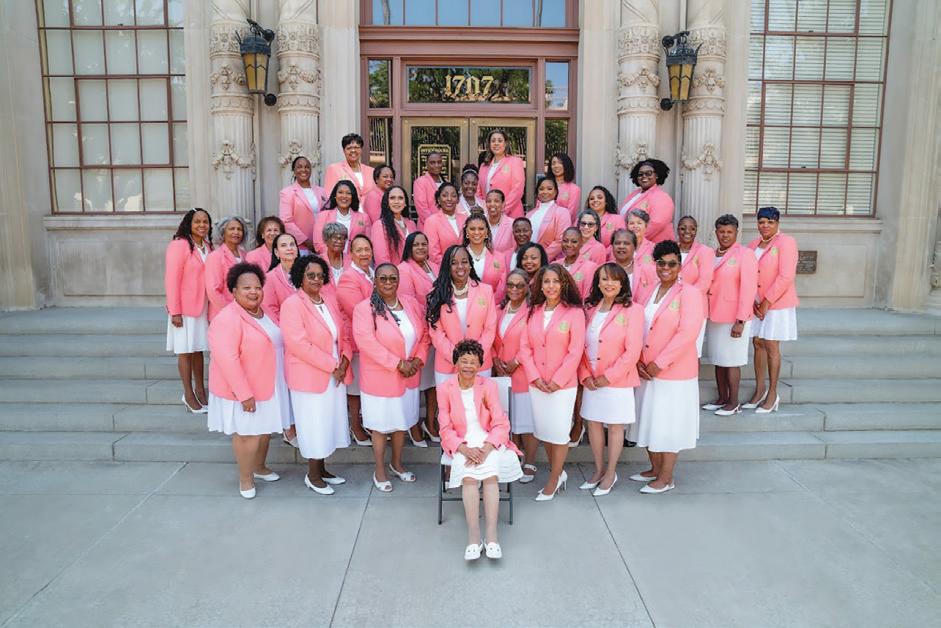
These projects included an array of talents and displays such as poems, visual performances, and instrumental performances. These showcases demonstrated the culmination of the Youth Leadership Institute and the hard work and dedication the students exhibited to honor their accomplishments.
“They Youth Leadership Institute graduates] are different students than when they first walked in the door. They are leaders now!” exclaimed Dr. Vivian Gayles, Youth Leadership Institute Advisor.
Amongst family and supportive community members were dignitaries who sought to show the YLI graduates that through hard work comes success. Some of the esteemed officials included Vice Mayor Andrae Gonzales, Kern High District Superintendent Dr. Michael Zulfa, Assistant Superintendent Leo Holland, and community philanthropist Attorney Curtis Floyd. The vice mayor presented the students with certificates of achievement for successfully completing the Youth Leadership Institute and excelling in the course. Attorney Curtis Floyd was recognized for his generosity and investment in the program.“These are all shining stars, and to be able to have this experience before they show up in high school means that they are going to be the leaders on the campuses in the Kern High School District in the future,” said Dr. Michael Zulfa, Kern High School District Superintendent.
Brittinae Phillips, Senior Education Manager at Planned Parenthood Los Angeles’s Black Health Initiative (Courtesy Photo)
Jason Land, Jr. Contributing Writer In light of the inaugural class of Alpha Kappa Alpha Sorority’s
